Back to recent reviews
Allira Wilson - Rise and Fall
Mark Turner Quartet - Lathe of Heaven
Paul Grabowsky - Solo
BLOW - Presence
Frode Haltli - Vagabonde Blu
Magnusson, Oehlers, Vanderwal - Paper Tiger
Calum Builder and Tate Sheridan - In Hiding
Mark Turner Quartet - Lathe of Heaven
Shol - Shol
Mike Nock Octet - Suite Sima
The Bad Plus - Inevitable Western
Wangaratta Jazz & Blues Festival 2014
Alex and Nilusha - Tales to Tell
Robert Burke with Kenny Werner - Do True
Kavita Shah - Visions
Keith Jarrett and Charlie Haden - Last Dance
Song Fwaa - Songs of No Guns For We Are Anomalous
Henri Peipman - 30. Detsember
Mathew Sheens - Untranslatable
Hammerhead - Mozaic
Penny King Quintet - Journey
Adrian Cunningham - Ain’t that Right! The Music of Neal Hefti
Tom Barton - Aspirations
Jex Saarelaht Trio - Liminal
The Hunters and Pointers - The Hunters and Pointers
Melissa Oliveira - In My Garden
Gwilym Simcock - Instrumation
Daniel Susnjar - Su Su Nje
Kim Lawson Quartet - Hey Day
The Nexus Project - First Light
Melbourne International Jazz Festival May 30–June 8, 2014
Java Quartet - Together
Paul Grabowsky Sextet - The Bitter Suite
Dizzy Gillespie - The Champ
Robert Davi - Davi Sings Sinatra
Eric Starr Group - Such is Life
BluesFest 2014
Sam Bates Trio - Backblocks
Ben Panucci Trio - Short Stories
James Greening - Greening From Ear to Ear, Tam O’Shanter Tales
Alex Stuart - Place to Be
Tilman Robinson - Network of Lines
Eamon Dilworth - Tiny Hearts
Bob Venier - Discovering You
Brendan Clarke - Stretch
Julian Curwin - The Mango Balloon Volume 3
Daniel Hunter - The Twentieth
Mike Rivett - Digital Seed
Quentin Angus – Perception
Alfredo Rodriguez - The Invasion Parade
Danilo Perez - Panama 500
Joe McEvilly with Movement 9 - Wings
Anton Delecca Quartet - The Healer
Sam Anning Trio - Sweethearts
Chet Baker - The Italian Sessions
Dexter Gordon - Blows Hot and Cool
Curtis Counce - Complete Studio Recordings
Peggy Lee - Mink Jazz
Lou Donaldson - Midnight Creeper
Ahmad Jamal - It’s Magic
Chris Poulsen Trio - David and Goliath
Anton Delecca Quartet - The Healer
Ross McHenry - Distant Oceans
Scott Hamilton and Dusko Goykovich - Tight But Loose
Elodie Sablier - Vertigo
Celine Rudolph - Metamorflores
Dusko Goykovich - 5ive Horns & Rhythm
Dusko Goykovich1 - Sambo Do Mar
Dusko Goykovich2 - Samba Tzigane
Red Prysock - The Best of Red Prysock
Scott Hamilton - Swedish Ballads
Pee Wee Ellis - Tenoration
Andrea Keller Quartet with Strings - Wave Rider
Divergence Jazz Orchestra - The Opening Statement
Paul Williamson - Connect Four
2013 ARCHIVES:
Janet Seidel and Friends - Far Away Places
Julien Wilson Quartet - This is Always; Swailing
Monash Art Ensemble (Australian Art Orchestra and Sir Zelman Cowen School of Music)
Simon Thacker's Svara Kanti - Rakshasa
Todd Hardy - Swings and Roundabouts
Captain Kirkwood - Theseus and The Minotaur
Wangaratta Jazz & Blues Festival 2013
Adam Katz - Adam Katz
Resurgence - Duende
States of Play - States of Play
Monash students & overseas artists. The Monash Sessions
Compass Quartet - Oneirology
Keith Jarrett Trio - Somewhere
Hannaford Tinkler and Barker - Faceless Dullard
Steve Newcomb Orchestra - Caterpillar Chronicles
The Vampires - Tiro
The New Cabal
Jonathan Zwartz - The Remembering & Forgetting of the Air
Angela Davis - The Art of The Melody
Yitzhak Yedid - Suite in Four Movements
Paper Plane
Leigh Carriage - Mandarin Skyline
Melbourne International Jazz Festival May 31-June 9 2013
Monique DiMattina - Nola's Ark
Tom Vincent Quartet - Just Enough
Tomasz Stankos New York Quartet - Wistawa
Neil Cowley Trio - The Face of Mount Molehill
Charles Lloyd and Jason Moran - Hagar’s Song
Cecile McLorin Salvant - Woman Child
The catholics - Yonder
Origami - Karaoke
Origami - The Usefulness of Art
Mike Nock and Howie Smith - Opal Dream
BLOW - Empathy
Kjetil Moster - Moster! Edvard Lygre Møster
Edouard Bronson - Intimate
Alex Stuart - Around
Jess Greens Bright Sparks - Tinkly Tinkly
Charmaine Jones and Mike Bevan - Still
Trichotomy - Fact Finding Mission
Phronesis - Walking Dark
Steve Barry - Steve Barry
Alister Spence Trio - Far Flung
Chris Potter - The Siren
Matthew Sheens - Every Eight Seconds
Marialy Pacheco - Spaces Within
Joseph Tawadros - Chameleons of the White Shadow
Ted Vining Trio - Live at PBS FM 1981
Nostalgia 77 - The Sleepwalking Society
Wayne Shorter - Without A Net
Dave Jackson Quartet - Cosmontology
Bobo Stenson Trio - Indicum
Wangaratta Jazz & Blues Festival 2012
Daramad - Daramad
Penelope Sai - Siana
John Surman - The Rainbow Band Sessions
Murphy's Law - Big Creatures and Little Creatures
Slumgum - The Sky his Own
2012 ARCHIVES:
Gregg Arthur - Unforgettable – A Portrait of Nat ‘King’ Cole
Conly, Harding, Jones, Taylor - Grass Roots
Mace Francis New York Nonet - Land Speed Record
Magnet - Magnet
Willow Neilson - Lightbulb Life
Wangaratta Jazz & Blues Festival
Moskus - Salmesykkel
Marc Johnson and Eliane Elias - Swept Away
The Andy Sugg Group - The Berlin Session
Abel Cross Quintet - Neo Bop
Diana Krall - Glad Rag Doll
Divergence Jazz Orchestra- Live at the Bald Faced Stag 29/7/12
Seaman Dan - Sunnyside
Sean Wayland - Slave to the Machine (Volumes 1 & 2)
Logic Live (Double DVD/CD)
Mike Nock and Laurenz Pike - Kindred
James Carter - After All
Tony Gould and Peter Petrucci - The Journey Home
Matthias Schriefl - Six, Alps & Jazz
Simcock, Garland, Sirkis - Lighthouse
Jacam Manricks - Cloud Nine
Sarah McKenzie - Close Your Eyes
Bernie McGann - Wending
Craig Scott Quintet - Timeline
Marialy Pacheco 11th August 2012 – Coffs Harbour
Phil Treloar - Of Other Narratives - tracings in the ground of. Collective Autonomy / Volume 3 - Primal Communication
Mike Stern - All Over the Place
Neneh Cherry and The Thing - The Cherry Thing
John Abercrombie Quartet - Within a Song
Josh Kyle - Possibilities
John McAlls Black Money - Alter Ego
Peter J Martin - Waltz for the Wicked
Lily Dior - Let's Talk About It
Wayne Krantz - Howie 61
Motion - The Drowned World
Renaud Garcia-Fons - Solo – The Marcevol Concert
Tim Stevens - Life's Undertow
Guy Strazz Quartet - Eastern Blues
Melbourne International Jazz Festival 2012
Daimon Brunton Quintet - Wha Sa Live
Tim Willis and The End - Keep Your Chin Up
Tim Clarkson - Evolution of Beauty
Vijay Iyer Trio - Accelerando
Esbjorn Svensson Trio - 301
Phronesis - Walking Dark
Melody Gardot - The Absence
Tony Gorman - Tony Gorman's Monday Club
Barney McAll - Graft
Skii Harvey - Bound by History
Sandy Evans and Friends with Guru Kaaraikkudi Mani and Sruthi Laya - Cosmic Waves
Buck Clayton - The Complete Legendary Jam Sessions: Master Takes
Dick Hyman Trio - You're My Everything
Trombone Shorty - For True
Jens Thomas - Speed of Grace
Ben Hauptmann - Yum Yum Tree RecordsCC
David Murray Octets - The Complete Remastered Recordings on Black Saint
Galaxstare - A Time, Times and Half a Time
David Ades & Friends - A Glorious Uncertainty
Tal Cohen Quartet - Yellow Sticker
Alfredo Rodriguez - Sounds of Space
Alex Pertout and Nilusha Dassenaike - Moments in Time
2011 ARCHIVES:
Benjamin Sanz Quintet - Mutation Majeure
Houston Person - So Nice
Compass - Ode to an Auto Rickshaw
The Vampires - Garfish
Charmaine Jones and Mike Bevan - A Small Hotel
Slide Albatross
Marc Hannaford - Ordinary Madness (Quintet) and Sarcophile (Trio)
Dave Brubeck Quartet - Their Last Time Out
Nicki Parrott - Can't Take My Eyes Off You
Keith Jarrett - Rio
Nick Haywood Quartet - 1234
Kellylee Evans - Nina
Ella Fitzgerald - S'Wonderful: Ella in Japan
Liam Burrows With John Morrison's Swing City - All of Me
Michael Feinstein - The Good Life: The Sinatra Project, Volume Two
Gadjo Guitars - L'Amour En Douce
Bridie King - Blue Ivories
Andy Sheppard, Michel Benita and Sebastian Rochford - Trio Libero
Maggie Britton - Ditto – Songs for Alexander
Christian McBride - Conversations with Christian
Phil Treloar - Of Other Narratives
Jeff Riley - Jazz Suite
Quentin Angus Quintet - Retrieval Structure
Robert Burke, Tony Gould, Tony Floyd and Nick Haywood - Live at Bennett's Lane
Mike Nock Trio Plus - Hear and Know
Peter Knight - Fish Boast of Fishing
Marialy Pacheco - Songs that I Love
Bucky and John Pizzarelli - Generations
Emma Grace Stephenson - Jazz Workshop AustraliaCC
Warren Vache and Bill Charlap - 2gether
Ella Fitzgerald - Live at Mister Kelly's
Cedar Walton - Voices Deep Within
Samurai Spirit - Ganbare Nippon
Warren Wolf - WW
Ella Fitzgerald - Best of the BBC Vaults
Rebecca Kilgore with Harry Allen Quartet - Live at Feinstein's: Celebrating Lady Day and Prez
Nick Hempton - The Business
James Whiting - Burbank
Keith Jarrett - Rio
Compass Quartet - Ode to an Auto Rickshaw
Darius Jones Trio - Big Gurl [Smell My Dream]
Memory of Elements - MoE
Laura Fygi - The Best is Yet to Come
"Buck" Pizzarelli and the West Texas Tumbleweeds - Back in the Saddle Again
Dave Ades & Friends @ Venue 505 (9/11/2011)
Wangaratta Festival of Jazz 2011
Sean Jones - No Need for Words
Peter Knight and Dung Nguyen - Residual
Takadimi - New Common Sense
Ingrid James & The Global Collective - Pangaea
Origami Trio - The Blues of Joy
The Andrew Dickeson Quintet - Weaver of Dreams
The Paul McNamara Trio - IndependentCC
Karrin Allyson - Round Midnight
Nicki Parrott and Ken Peplowski - Like a Lover
Rossano Sportiello Trio - Lucky to be Me
Stan Getz - The Clef and Norgran Studio Albums
Sherrie Maricle and The DIVA Jazz Orchestra - Johnny Mandel: The Man & His Music
Leonie Cohen Trio - Sideshow Pony
Cedric Hanriot - French Stories
Laura Kahle - Circular
Lee McAllistair - Spellbound
Adrian Cunningham - Walkabout
Sandy Evans Sextet - When the Sky Cries Rainbows
Mace Francis Orchestra - Chinese Whispers IV
Katie Noonan Elixir - First Seed Ripening
Matt Keegan Trio - Meets David Ades
Harold Lopez-Nussa Trio - El Pais de las Maravillas
Dan Barnett - Somewhere, Some Place, Some Time
Scott Hamilton and Rossano Sportiello - Midnight at Nola's Penthouse
Bill Charlap - I'm Old Fashioned
Duke Ellington - The Great Concerts: London & New York 1963-64
Melbourne International Jazz Festival 2011
Howard Alden - I Remember Django
Elly Hoyt - Pinnacle
Sarah McKenzie - Don't Tempt Me
Jeremy Pelt - The Talented Mr Pelt
My Goodness McGuiness - Insular Peninsula
Pascal Schumacher Quartet - Bang My Can
Browne, Hannaford, Anning - Shreveport Stomp
Cameron Earl Quartet - Run Run
Daniel Gassin Sextet - Which Way
Fran Swinn Trio - Every Dog
Joachim Kuhn, Majid Bekkas and Ramon Lopez - Chalaba
Portico Quartet - Knee-deep in the North Sea
Matt Baker - Underground
Luke Howard and Janos Bruneel - Open Road
The End - The End
Jason Moran and The Bandwagon - Ten
Briana Cowlishaw - When Fiction Comes to Life
Art Tatum - Solo Masterpieces
Allan Vache - Look To The Sky
Jacam Manricks - Trigonometry
Quinsin Nachoff - Forward Motion (FoMo)
Song Fwaa - Ligeti's Goat
Jane Monheit - Home
Bill Allred Featuring John Allred - The New York Sessions
Duke Ellington - From His Treasure Chest 1965-72
David Klein Quintet - My Marilyn
3ofMillions - Abstruction
BluesFest 2011
Amphibious - Alive & Breathing
Jane Irving - Beams
Tim Stevens Trio - Scare Quotes
James Osborne Jazz Collective - Playtime
Renaud Garcia-Fons - Mediterranees
Mark Isaacs's Resurgence Band - Aurora
Nicki Parrott - Black Coffee
"Buck" Pizzarelli and the West Texas Tumbleweeds - Diggin' Up Bones
Lew Soloff and Steve Richman - Sketches of Spain
2002-2010 ARCHIVES
|
Reviews
 
 
 -
masterpiece, -
masterpiece,
 
 -
excellent, -
excellent,
  - good
- good
 - fair, - fair, - poor - poor
To Search for reviews - Key CTRL+F and artist or album name
| 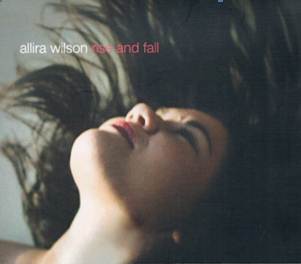 | Allira Wilson - Rise and Fall (Independent)
|
Vocalist Allira Wilson is another talented graduate from that Perth wellspring of talent the Western Australian Academy of Performing Arts (WAAPA) at Edith Cowan University. Foremost in the accompanying quintet, saxophonist Jamie Oehlers is a senior music lecturer at the academy and each member of the group has studied there
Wilson took out Best Australian Jazz Vocal award at the 2014 Bell Awards and this debut album of three originals and seven standards signals the arrival of an important new voice in Australian jazz. Of the originals, the title track is a standout, opening with a wordless vocal in unison with the tenor sax, transitioning smoothly into a soft ballad given rhythmic complexity by drummer Ben Vanderwal’s quadruple timing. Oehlers’s solo on this Wilson composition captures flawlessly the misty fragility of the vocalist’s style and flows into a reprise of the opener with Wilson to conclude
Jerome Kern’s I’m Old Fashioned is taken at a medium tempo and gives Wilson free reign to modify the melodic line, not scatting but utilising the original lyrics as Tal Cohen delivers a swinging, sympathetic backing and a rippling solo over Sam Anning’s strong bass foundation. Another Kern standard The Way You Look Tonight also receives a cleverly altered melody, improvising by making inventive use of the lyrics
Wilson’s Chapter of Change features a silky backing from Christopher Sealey’s contributory but unobtrusive guitar as the vocal wends gently and expressively, almost out of tempo, up into perfectly pitched, hushed high notes
This is a valuable collection by a notable new vocalist in supportive arrangements by skilful practitioners
   
|
John McBeath
Previously published in The Australian Dec 2014 |
| Back to Index |
| 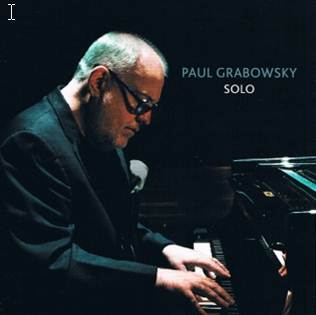 | Paul Grabowsky - Solo (ABC Jazz)
|
Pianist and music polymath Paul Grabowsky claims this solo piano recording has been a long time coming, and clichés about the worthiness of the wait are barely adequate for this splendid collection. The program of eight originals and two standards opens with Angel, a beautiful ballad and Grabowsky favourite that encompasses the breadth and depth of a Schoenberg piano piece. In refracted hints of that classical composer there are sparsely used, carefully chosen opaque atonal chords, delicate high treble statements and flourishes, and a deep sumptuousness, but the whole is imbued with unmistakable jazz influences. Those aspects are evident throughout this unhurried album where the essence is introspection infused with sparkling invention
The standard, I Get Along Without You Very Well is perfectly suited to the mood as Grabowsky guides it sensitively through its meandering trail of beautiful harmonies. The other standard ‘Round Midnight extends Monk’s already extended chords even further and imparts an out-of-rhythm feel to the piece that almost, but never quite, drops it right out of tempo. There’s an almost visual sketch conjured in Helix as the melody winds and spirals to portray the title, while Stars Apart engenders a cosmic wandering in a performance that would make an ideal soundscape for a slow pan by the Hubble telescope
Solo is co-produced by ABC Jazz’s Gerry Koster, presenter of ‘Jazz Up Late’. This album is a rarity where the subject imagery of music titles is painted with superb imagination and interpretation, and all with Grabowsky’s seemingly effortless technique
    
|
John McBeath
Previously published in The Australian Dec 2014 |
| Back to Index |
| 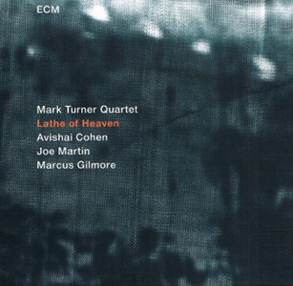 | Mark Turner Quartet - Lathe of Heaven (ECM)
|
This is the first recording since 2001of Mark Turner as a leader. His chordless quartet adds trumpet, bass and drums to Turner’s tenor sax. Dubbed by the New York Times as ‘possibly jazz’s premier player,’ this is Turner’s first album for the prestigious ECM label, although he’s been an important sideman for Kurt Rosenwinkel, Jeff Ballard, Enrico Rava, and many others. Turner’s approach is cerebral, but a soul infusion is always present. The pairing with Avishai Cohen on trumpet works extraordinarily well, both together and in the intricacies of their individual solos
The opener and title track – all six are Turner originals – has the trumpet stating the theme as the sax moves underneath and gradually Joe Martin’s bass adds a couple of notes every two bars, until Marcus Gilmore’s drums join in as Turner vigorously lifts off. Ethan’s Line invokes pianist Ethan Iverson, from The Bad Plus, with whom Turner has collaborated, and its gracious theme gives both trumpet and sax space for inspired solos
Martin’s thoughtful bass solo begins Sonnet for Stevie, a tribute to Stevie Wonder, imbued with a blues sensitivity that Turner explores characteristically utilising the entire range of the horn using expression minus exhibitionism. Cohen’s lengthy solo is reminiscent of Miles Davis’s iconic work on ‘Kind of Blue’. The duo theme playing on Year of The Rabbit is both sensitive and precise, and Cohen delivers a marvellously soaring solo ahead of Turner’s insightful and thought-provoking improvisations
This is a collection in mostly medium tempos, always rhythmically flexible, where intelligent ideas are brilliantly interpreted
    
|
John McBeath
Previously published in The Australian Dec 2014 |
| Back to Index |
| 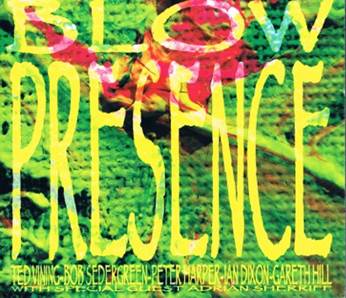 | BLOW - Presence (Independent/Planet)
|
Following their 2013 release Empathy, Melbourne-based quintet BLOW retain the same personnel for their sixth album. The collection maintains the group’s contemporary approach with an interesting mix of rhythmic post-bop and out of tempo, free group improvisation. The title track is a good example of the former with Bob Sedergreen’s swinging piano opening and a theme taken up by the duo of Peter Harper’s tenor and Ian Dixon on flugelhorn before the tenor breaks out and Dixon supplies high-flying embellishments to Harper’s solo
Two shortish tracks, Deep Earth One and Two move into free experimentation in which Gareth Hills’s acoustic bass and Ted Vining’s drums add important components to an impassioned and frenzied mix. The longest track at under ten minutes Blues For a Paradox, begins with soft, abstract drum strokes under a bluesy flugelhorn ahead of a strong bass riff establishing a medium slow tempo for piano and the two horns to deliver the soul-infused melody. Then it’s expressive solos from both soaring flugelhorn and angular piano leading to a languid conclusion on a steady bass foundation
Guest artist Adrian Sherriff appears on Until playing a shakuhachi Japanese flute in a minor scale on a medium tempo piece and provides an energetically flourishing solo pushed along by piano and vigorously skilful drumming. A brief piano trio intro with robust bass introduces Dixon’s dynamic flugelhorn on Lionshare as Sedergreen supplies the rhythmic chords and the tenor takes over as Dixon interweaves brass filigrees
Overall the new album features strong rhythmical approaches in an advanced mainstream context with occasional forays into ‘out there’ abstraction
   
|
John McBeath
Previously published in The Australian Dec 2014 |
| Back to Index |
| 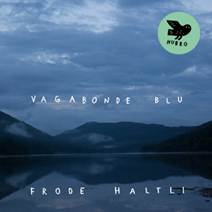 | Frode Haltli - Vagabonde Blu (Hubro HUBROCD2546)
|
This is a live concert recorded in Oslo's Tomba Emmanuelle in 2009. The unique room, which was once the studio of artist Emanuel Vigeland, lends itself to the unique atmospherics of this performance. The artist renovated the studio into his own mausoleum and despite the presence of the artist’s urn, the acoustics take on a vibrant life of their own to the point that it is almost impossible to communicate effectively in the room
Solo accordion won’t be everyone’s cup of tea. It seems this music is presented with an artistic approach of minimalism coupled with moments of high drama. Frode Haltli takes on three compositions by composers Salvatore Sciarrino, Arne Nordheim and Aldo Clementi and each are distinctive within the context of this setting
Vagabonds blu opens with great tension utilising various effects both of distortion and percussive morphing into a call and response segment of monotone explorations captured with subtlety but exaggerated by the natural acoustics. It is difficult to differentiate the notated and the improvised but it certainly pulls you into both meditative and uncomfortable places.
Flashing reminds me of waking up in front of a tv test pattern when the channel is no longer on air. The accordion morphs into something more sinister, akin to a murder mystery or even a horror film score, with thunderous lightening strikes and jolting thunder. Accordion is rarely heard in such dramatic realms.
Perhaps Ein Kleines is the most melodious of the three pieces and is the most lengthy at 18 minutes. The accordion takes on church pipe organ proportions of sound
   
|
Peter Wockner
|
| Back to Index |
| 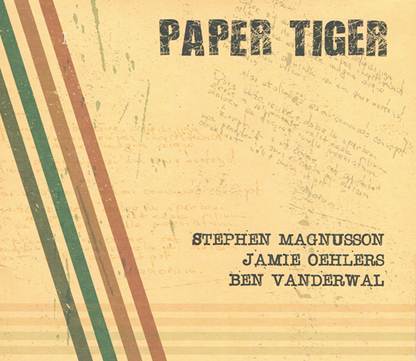 | Magnusson, Oehlers, Vanderwal - Paper Tiger (Assemblers Records)
|
This trio collection suffers not at all from the absence of a bass, since guitarist Stephen Magnusson and especially drummer Ben Vanderwal provide a more than adequate foundation for Jamie Oehlers’s tenor sax. There are compositions by each member of the group plus four standards included in the 15 tracks. The title track by Oehlers is an interesting, if melodically unpredictable theme, and a good example of the group’s supportive integration: sometimes sax and guitar play in unison as Vanderwal works the drum kit busily and with melodic understanding. After Oehlers’s energetic solo, underpinned by the guitar’s running bass line, the piece slows to a sagging stop, only to be revived for a final chorus by a vigorous drum solo
The longest track at over eight minutes is an unlikely inclusion: Frank Loesser’s 1948 hit Slow Boat to China taken at a relaxed tempo with wandering elements in the interplay between sax and guitar. Keith Jarrett’s Backhand is the opener with Oehlers moving authoratively through the post-bop theme before launching into a travelling solo, urged along by both drums and guitar; Magnusson’s swinging solo is given added impetus by saxophone riffs and the driving drums. Vanderwal’s composition A Song To Parallel Park To has a repetitive opening with an insistent rhythm devolving into abstraction, while Magnusson’s So It Goes is a tranquil ballad floating serenely along with guitar and sax’s reciprocal interchanges
These three top level players, work beautifully together, by listening acutely and reacting perceptively to the ideas and input from each other.
   
|
John McBeath
Previously published in The Australian Nov 2014 |
| Back to Index |
| 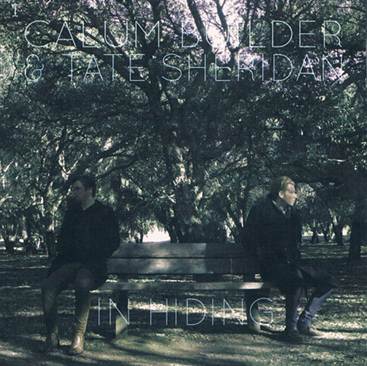 | Calum Builder and Tate Sheridan - In Hiding (Independent)
|
It’s pleasing to hear a debut album by two final year students in Canberra – saxophonist Calum Builder and pianist Tate Sheridan – from the ANU School of Music. With funding from Friends of the School, the duo have been composing and recording these original works for the past year resulting in a relaxed-sounding, highly listenable collection. There’s a floating quality to these pieces; they’re mostly introspective, but always brimful of fresh ideas. The opener My Lord – and longest track at over eight minutes – sets the mood with an alto sax cadenza flowing tranquilly into a rhythmic sequence above a piano riff. A similarly placid atmosphere pervades Piece by Peace where Builder takes up a soprano sax – as he does on two other tracks – to explore a pastoral theme with Sheridan’s thoughtful and sensitive contributions as the performance gathers strength and power
Amongst a soothing, mostly ethereal collection, Czech Mate is the only piece to espouse a bop theme moving in a vigorous alto and piano combination before an energetic sax solo underpinned by the piano’s running bass line which develops into a fine, swinging solo complete with a stomping stride section. The closer, Stable Change begins with a stately, spacious theme established by the piano which then is joined by the unison alto in a work reminiscent of the music of a religious chorale
This unusual album of duo performances, by two players who understand each other’s approach perfectly, has a pleasantly sedate quality that will best suit a contemplative listener
   
|
John McBeath
Previously published in The Australian Nov 2014 |
| Back to Index |
| 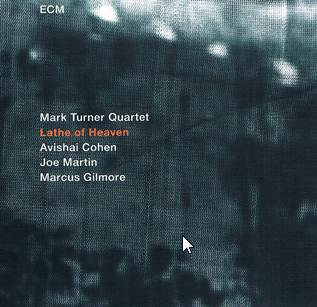 | Mark Turner Quartet - Lathe of Heaven (ECM)
|
This is the first recording since 2001of Mark Turner as a leader. His chordless quartet adds trumpet, bass and drums to Turner’s tenor sax. Dubbed by the New York Times as ‘possibly jazz’s premier player,’ this is Turner’s first album for the prestigious ECM label, although he’s been an important sideman for Kurt Rosenwinkel, Jeff Ballard, Enrico Rava, and many others. Turner’s approach is cerebral, but a soul infusion is always present. The pairing with Avishai Cohen on trumpet works extraordinarily well, both together and in the intricacies of their individual solos
The opener and title track – all six are Turner originals – has the trumpet stating the theme as the sax moves underneath and gradually Joe Martin’s bass adds a couple of notes every two bars, until Marcus Gilmore’s drums join in as Turner vigorously lifts off. Ethan’s Line invokes pianist Ethan Iverson, from The Bad Plus, with whom Turner has collaborated, and its gracious theme gives both trumpet and sax space for inspired solos
Martin’s thoughtful bass solo begins Sonnet for Stevie, a tribute to Stevie Wonder, imbued with a blues sensitivity that Turner explores characteristically utilising the entire range of the horn using expression minus exhibitionism. Cohen’s lengthy solo is reminiscent of Miles Davis’s iconic work on ‘Kind of Blue’. The duo theme playing on Year of The Rabbit is both sensitive and precise, and Cohen delivers a marvellously soaring solo ahead of Turner’s insightful and thought-provoking improvisations
This is a collection in mostly medium tempos, always rhythmically flexible, where intelligent ideas are brilliantly interpreted





|
John McBeath
Previously published in The Australian Nov 2014 |
| Back to Index |
| 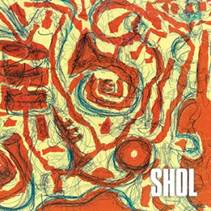 | Shol - Shol (Newmarket NEW3340.2)
|
Something tells me that the Melbourne band Shol doesn’t derive its name from the street acronym for ‘Subtle hints of lesbianism’ although their original composition titles could easily carry such subtlety. Rather and much more likely it’s derived from the first letter of the surnames of trumpeter Chris Skepper, pianist Andrew Harrison, bassist John O’Hagan and drummer Chris Lewis. Chris Pappas is the group’s newest member on tenor saxophone. The group derives its inspiration from the hard bop and free jazz of the 1960’s and 1970’s. It’s quite evident that Harrison has listened intently to pianist Don Pullen in the way his treble runs seem to scatter upwardly like a bird taking fright. Skepper’s trumpet and flugelhorn has a youthful rounded tone which is at its exploratory best on the pensive ‘Inner Sense of Beauty’. ‘The Persian Princess’ has middle eastern and sometimes flamenco undertones, but perhaps the groups definitive sound is on display with the Blue Note flavoured hard bop ‘A Journey Within’. The Pappas solo is simultaneously soul searching and agile. Its refreshing to see a solid unit writing original compositions specifically for their clearly evident inspirations
   
|
Peter Wockner
|
| Back to Index |
| 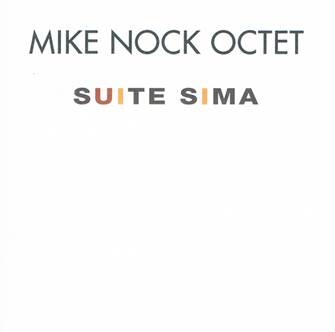 | Mike Nock Octet - Suite Sima (Fourth Way Music)
|
It’s doubtful whether the Sydney Improvised Music Association (SIMA) could receive a dedication of higher quality – in either composition or performance – than this suite of six originals by maestro Mike Nock, who recently celebrated his 74th birthday. Add seven more of Sydney’s top jazz performers and the suite becomes sweet indeed
The six tracks alter in mood and tempo from the sweeping impressionism of the mystical opener Freedom of Information to the post-bop big band style ofHolding Patterns with an amazing double tempo lift off trumpet solo of cardiac arrest potential from Phil Slater. Nock’s flowing piano begins Peripheralsleading into a saggy theme with sections alternating between piano and ensemble, led successively, by trombone, trumpet and alto sax. Peter Farrar’s alto launches a quick running solo, and just when it seems that a conclusion is looming James Greening steps in with an unaccompanied trombone solo, later joined by Brett Hirst’s bass and then James Waples’s drums bringing on an ensemble finale. Greening plays with a rare ability to shape and construct a virtuosic solo leavened with a substantial splash of humour
A slow bluesy piece, Frames of Reference features an exploratory solo by Karl Laskowski’s tenor as piano and ensemble provide a wide backdrop. Nock plays a Vintage Vibes keyboard on Parasympatheic Rebound and Carl Morgan’s guitar emerges from the group to swoop and pirouette ahead of the liquid cool, intertwining Rhodes keyboard. Nock’s unique ability in composition and especially his voicings of arrangements gives this octet as big a sound as twice as many instruments might produce
    
|
John McBeath
Previously published in The Australian Nov 2014 |
| Back to Index |
| 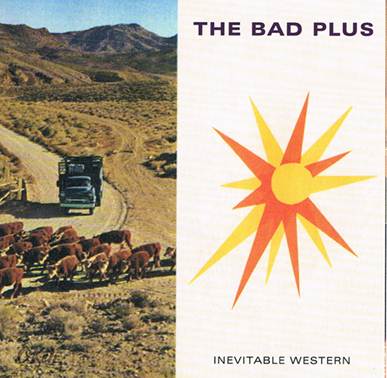 | The Bad Plus - Inevitable Western (Okeh/Sony Music)
|
Although this is the tenth studio recording from the fifteen year old New York piano trio, they haven’t quite achieved the recognition they deserve in Australia. This may partly be due to their genre-smashing approach with a repertoire consisting of their original music along with covers of artists as divergent as Nirvana, Neil Young, Aphex Twin and Ornette Coleman. They recorded Igor Stravinsky’s The Rite of Spring earlier this year for which Downbeat Magazine awarded five stars and included it in their top ten records of the year
The new one is all original with everyone contributing: pianist Ethan Iverson, Reid Anderson on bass and drummer David King. They’re exploring many musical forms – jazz, pop, blues, folk, classical melodies, all with rhythmic innovation, creating a rarity: intelligent music with broad appeal. Post-rock elements open Gold Prisms Incorporated with the piano’s rhythmic staccato treble chords against an understated rock beat as gradually the piano and a motile bass move into a lyrical semi-classical sounding interlude as the drums fall silent. But the mood changes again as drums reappear for jabbing chords and post-bop runs as the trio swells to a climactic finale.
The title track, after a tightly singing bass intro, begins with a slow tempo, clever harmonic take on western music – without ever sliding into cliché – evolving into a smartly swinging piano solo and then a classical sequence. Mr Now manages to combine an uptempo, free-flowing post-bop style with accessible melodies and harmonic complexity adding a speedy drum solo in the penultimate section
    
|
John McBeath
Previously published in The Australian Nov 2014 |
| Back to Index |
|
Wangaratta Jazz & Blues Festival
Various venues
Oct 31st – Nov 2nd
Expectations were high for the twenty-fifth anniversary of this iconic, annual festival. Its slogan: ‘Seriously good music,’ held promise and long-serving Artistic Director Adrian Jackson’s program delivered. There was a good mix of famous overseas names and outstanding locals plus opportunities for blending the two. There have been years when some of the imported headliners were disappointingly unimpressive, especially alongside top class Australian talent, but no such criticism applied in 2014.
Enrico Rava, at 75 years, arguably one of Italy’s best-known jazz musicians, opened the festival Friday night in an inspirational assemblage of students and faculty from Monash University’s School of Music. The sextet of changing personnel played Rava’s compositions led by him in a combination of fiery freedom and rhapsodic romanticism with a Miles-like usage of interstitial space.
Later on Friday the prestigious Australian Art Orchestra, under the directorship of Peter Knight, presented a major work Struttin’ With Some Barbecue, composed and led by Eugene Ball on trumpet. It was a contemporary portrayal of the life and music of Louis Armstrong by 11 performers using conventional instruments, laptop electronics, turntables, and abstract imagery. It didn’t always work perfectly; the story may have been better conveyed by adding a narrator, and less usage of crackly needle noise would have been welcome. But when the musicality of Ball’s panoramic arrangements came together the effect was powerful, as were several emotive vocals from ‘Ngaire’.
Saturday began with Rava leading a quintet of Australians in a program of standards. The trumpeter unleashed wild bursts of high-speed chromatics flying into the upper atmosphere. He used unorthodox sounds and also delivered a mellow sequence of interplay with Mirko Guerini’s fine tenor sax. Rava listens attentively to other’s solos and seemed especially to enjoy the always notable piano work of Paul Grabowsky. They wound up with a joyful rendition of the bop standard Doxy.
Expatriate Australian saxophonist Lisa Parrott now resident in New York played alto with a rich, warm tone, memorably on a bouncy Brazilian Choro piece Un Zero, and also blew baritone sax. Parrott’s finale was Lonely Woman’, a tribute to the late bassist Charlie Haden, given a splendid acoustic bass intro by Cameron Undy.
US multi-award winning drummer Jeff ‘Tain’ Watts appeared on Saturday afternoon in a small group led by his wife, another NY-based, Aussie expatriate Laura Watts, playing the tiny pocket trumpet. Unfortunately she was sometimes off mike, but all eyes were on her husband, one of the most creative and influential drummers in the jazz world. He looked calmly composed as ultra high-speed, strong percussive, punctuating and concise emphasising figures flew from his kit.
Two guitarists who tied in the 2000 National Jazz Awards, James Muller and Stephen Magnusson, came together this year to present an exhilarating program for jazz guitar. Muller’s high speed and complex lines were offset by Magnusson’s more lyrical approach. National Jazz Awards 2014 winner is guitarist Carl Morgan.
Saturday’s highlight came with Jeff ‘Tain’ Watts’s high-powered quartet in a late night performance featuring Watts’s compositions and a show-stopping version of Monk’s Brilliant Corners featuring saxophonist Troy Roberts from Perth, Cuban pianist Osmany Paredes and Chris Smith on bass. As they worked over Monk’s angular changes tempos were effortlessly alternated to double or triple time as the players pushed each other to unimaginable heights.
Sunday morning began with Sydney trombonist James Greening’s septet Greening From Ear to Ear and its brilliant front line of saxophonists Paul Cutlan and Andrew Robson plus the leader. Greening’s original, Lumpy saw the leader playing an enormous sousaphone accompanied by baritone sax and bass clarinet.
Many others deserved descriptions if space permitted: the ‘out there’ trio Drub with virtuosic trumpeter Scott Tinkler; stylish US quartet Spoke; outstanding NZ saxophonist Roger Mannins; Allan Bowne’s quintet with a new 10 part composition The Odyssey; Sam Keevers’s quintet playing Bernie McGann; Mike Nock’s trio plus two, and more.
Sunday night’s closer brought back the Watts quartet to again move tempos from leisurely to fast to frenetic and back again within a few drum shots.
The twenty-fifth edition of ‘Wang’ will be remembered as a monumental program of towering talent and diversity.
|
John McBeath
Previously published in The Australian Nov 2014 |
| Back to Index |
| 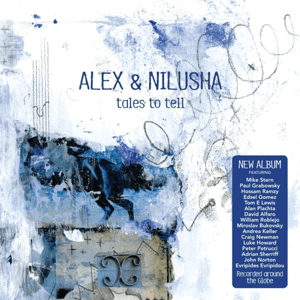 | Alex and Nilusha - Tales to Tell (Whispering Tree Music WTM 003)
|
One of the beauties of music is that it has no borders. Tales to Tell is further proof that music has wholeheartedly adopted the global village concept of the 21st century. The voice and percussion remain the most primitive forms of musical expression. But here there are many origins of music either implied or used for inspiration from regions including south Asian, Middle-Eastern, African, Caribbean, Latin and indigenous Australia. Tales to Tell is a compelling cross-cultural collaboration for percussionist Alex Pertout and vocalist Nilusha Dassenaike. A number of guests appear including guitarist Mike Stern and pianist Paul Grabowsky. The melodies are both catchy and challenging for vocals but Nilusha’s voice is malleable enough to envelope the harmonies and rhythms with consummate ease
Four traditional folk melodies are amongst the originals penned by the duo. Pertout uses a variety of modern and primitive percussion instruments. In the Latin Un Mismo Camino he illuminates the rhythms with congas, cajon, shaker, claves, cymbals, vibes and marimba while Hossam Ramzy adds an Egyptian flavour on tabla along with Norton on oud. Grabowsky teasingly plays against the beat and Mike Bukovsky’s flugelhorn provides a jubilant call against the overdubbed background vocals of Nilusha
Little promises is a traditional Sri Lankan folk song which features guitarist Mike Stern on lead and rhythm guitars. Rhythmically driven, it also features the Konnakol (South Indian Carnatic vocal percussion) styling of Pertout. Whilst the level of layering and production with this recording is lofty, it only acts to focus attention on the wondrous voice of Nilusha and the hypnotic kaleidoscope of Pertout
   
|
Peter Wockner
|
| Back to Index |
| 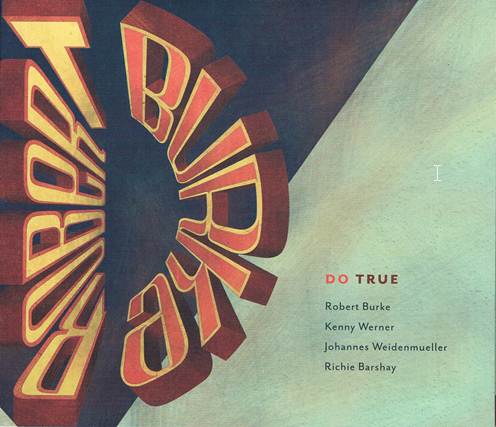 | Robert Burke with Kenny Werner - Do True (Jazzhead)
|
Well-established Melbourne saxophonist Robert Burke has appeared on over 200 CDs ranging from pop/rock acts to contemporary jazz, he’s toured extensively throughout Asia, Europe, the US and Australia, and he’s been Coordinator of Jazz and Popular Studies at Monash University’s School of Music for over ten years. This latest album was recorded in New York with Burke fronting a trio of US musicians led by pianist Kenny Werner. It’s a combination of compositions by Burke and Werner plus one by Paul Grabowsky. Werner a native New Yorker, is a highly experienced pianist and composer, author of Effortless Mastery, a book dealing with musical freedom for musicians, and currently is Artist in Residence at NY University
The opener and title track by Burke begins with a lengthy free-style tenor cadenza into which soft piano and percussion sounds gradually enter. As the sax races hoarsely forward out of tempo and then drops into the ballad-like theme – with a faint echo of Autumn In New York – the trio adds rhythm with Johannes Weidenmueller’s bass work and Richie Barshay on drums supplementing Werner’s alternately fluid and stabbing piano. Grabowsky’s Angel, a very attractive melody has engaging solos from both piano and sax, while Werner’s Georgia James after a dodging, post-bop opening from piano and sax in unison flows satisfyingly into a strong piano sequence with a bluesy feel and an exploratory sax solo using occasional fast phrasing
This collection offers sufficient contrasts to make it a pleasurable album in which Burke’s tenor is well integrated with a fine New York trio
   
|
John McBeath
Previously published in The Australian Sept 2014 |
| Back to Index |
| 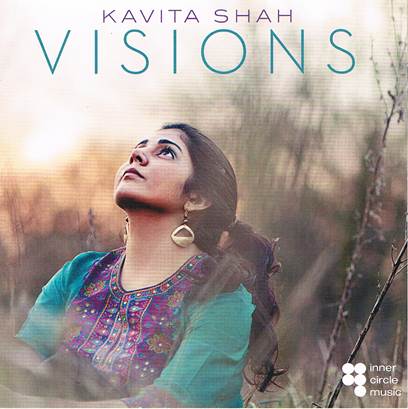 | Kavita Shah - Visions (Inner Circle Music)
|
In this New York recording vocalist Kavita Shah has no fewer than 14 musicians supporting and the music reflects her background in Mumbai and Brazil. There are several Ragas, a tabla interlude and songs in Portuguese. Co-produced by Shah and guitarist Lionel Louecke, the songs range across Shah’s arrangements of numbers by well-known composers together with several of her own compositions. The title track like the original by Stevie Wonder is delivered in a Latin rhythm but there’s more rhythmic emphasis here using drums, percussion and tabla. A vocal chorus is included in Visions and ex-Australian pianist Steve Newcombe provides a flashing solo
The blues-inflected Joni Mitchell song Little Green also features Newcombe’s piano along with Michael Valeanu’s guitar and a pretty kora (African harp) solo from Yacouba Sissoko as Shah’s voice, softly at first, gains force and climactic strength and then modulates to a gentle conclusion. Wayne Shorter’s Deluge with Shah’s lyrics includes an appropriate alto sax solo from Steve Wilson and features the vocalist’s scat over tabla, kora and percussion. Three ragas each add a string quartet to traditional-sounding Indian music and there’s some outstanding tabla from Stephen Cellucci in passages alternating with the vocalist’s Hindi phrasings. A reprise of the anguished Portuguese opener Sodade (Sadness) is the final track delivered in a very slow, delicate arrangement for vocal and acoustic guitar
This is an unusually varied collection in both content and arrangements, bridging influences from Africa, India and Portugal. In addition to Shah’s vocals, Special attention, is given to her arrangements which achieve a quite grand, sweeping quality
   
|
John McBeath
Previously published in The Australian Sept 2014 |
| Back to Index |
| 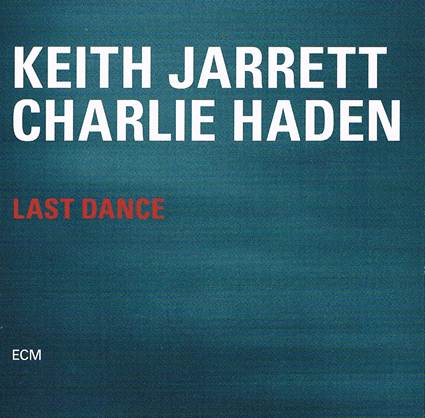 | Keith Jarrett and Charlie Haden - Last Dance (ECM/Fuse)
|
This album is both appropriately titled and saddeningly timely, since pianist Keith Jarrett’s long-term partner, bassist Charlie Haden died in July this year aged 76. After regular performances in Jarrett’s quartet from 1967 to 1976 the two didn’t play together again until 2007 when they recorded two albums over four days at Jarrett’s home studio: Jasmine released in 2010 and now the release of Last Dance. Each is a collection of nine deeply-felt standards with two songs Where Can I Go Without You, and Goodbye, included on both albums. It’s hard to imagine any other duo playing these numbers with greater warmth and intimate understanding than these two old friends
Ornette Coleman said of Haden: ‘He plays the music, not the background.’ And that ability is notable here as Haden’s perfectly selected notes swell beneath the melody in beautiful tones while Jarrett’s judicious interpretations drift easily into relaxed solos. Ballads such as Every Time We Say Goodbye, ‘Round Midnight, and Everything Happens to Me at medium-slow tempos are stocked with unpredictable melodic embellishments while Bud Powell’s Dance of The Infidels scampers along with ultra high-speed improvisation passages
Other deeply expressive slower renditions occur on It Might As Well be Spring – with a superbly engaging bass solo – and Where Can I Go Without You featuring graceful improvisations in chorus after chorus from both piano and bass. Haden had the last word on this partnership: “Keith really listens, and I listen. That’s the secret. It’s about listening.” And for an audience Jarrett and Haden make listening a memorable proposition
    
|
John McBeath
Previously published in The Australian Sept 2014 |
| Back to Index |
| 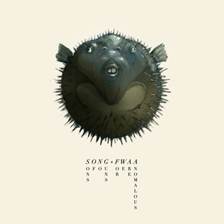 | Song Fwaa - Songs of No Guns For We Are Anomalous (Independent)
|
Song Fwaa is always going to provide a significant jolt to the senses. Their second album contrasts to their first with probably more space. In fact it’s the jagged air and sense of unpredictable fun that takes you by surprise and provides the jolt akin to negotiating the dodgem cars at the fair. Song Fwaa are Martin Kay alto saxophone, David Reaston guitar and Jamie Cameron drums. Much of their music almost streams like a fountain of spontaneity but there are certain frameworks that are frequently assembled then disassembled. It’s the artist’s ability to maintain seamless and overlayed shifts between those two designs, both pre-composed and spontaneously composed that both heighten the senses via complex time signatures and intuitive interplay. If you enjoy sounds from the ESP or Hubro labels you’ll enjoy Song Fwaa
   
|
Peter Wockner
|
The website of this eclectic Sydney trio establishes them as, ‘The wrong band for the right people.’ The name is eccentric too; it’s an approximation of the French sang froid, literally ‘cold blood,’ and colloquially: ‘coolness under pressure’. Their new album is a follow-up to Ligeti’s Goat, released in 2011 and continues a highly individual approach to their all-original material. A surprisingly diverse variety of sounds is produced by Martin Kay’s alto sax, David Reaston’s eight-string guitar and drummer Jamie Cameron, as they explore the outer fringes of esoteric expressionism
The music often combines aspects of free jazz – mostly rhythmic, albeit often in odd tempos – with contemporary classical ideas, reminiscent of Steve Reich and Philip Glass. Exemplifying these ideas are four different tracks entitled Tacet Suite, the first of which is subtitled ‘The sound of one eye crossing.’ All of the titles are unusual, sometimes with Joycean literary references: Twice Bitten Once Shy opening with a soft alto iteration over a guitar riff, gains compulsion as a mid-eastern rhythm arrives. Scotland Jop appends a Scott Joplin quote to the title and the piece sounds like ragtime meets Albert Ayler
Peculiar illustrates its title with high-speed alto underpinned by quick rhythmic strumming of muted guitar. It’s assumed that all sixteen tracks are at least to some extent notated since Kay or Reaston, or indeed the whole group, is credited as the composer but group improvisation is always a major component. The keynote is uncompromised abstraction, delivered by a cohesive trio of advanced ability and impressive integration
   
|
John McBeath
Previously published in The Australian Nov 2014 |
| Back to Index |
| 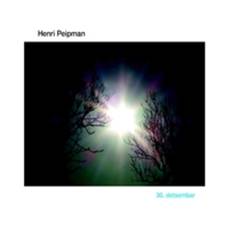 | Henri Peipman - 30. Detsember (Independent)
|
I’m surprised this release has not attracted more attention or airplay. It’s central theme is around the life of an Estonian and the subsequent invasion by Soviet forces so there is more than a hint of irony considering the current Ukraine war. Pianist and composer Henri Peipman’s second release is dedicated to his late father, indeed the title track 30. Detsember was the date of his passing. Not surprising then the overarching feel is often melancholy introspection with a touch of sadness. ‘Kyrie Eleison’ opens with a hymn-like melody played by saxophonist Spike Mason shifting to a meditative slower than heart-beat lament, accentuated by Tim Firth’s mallets and simmering cymbals. ‘Diaspora’ has an African feel but is actually based on his families escape from Soviet forces in Estonia. ‘Joy’ balances the disc with some brightness especially from Peipman’s deftly placed block chords. Anyone who enjoy’s the ECM sound won’t be disappointed with this recording. The space and the melodies hang in the air, seemingly within easy grasp. Spike Mason’s soprano and alto in these ballad settings drip with emotion and tenderness
   
|
Peter Wockner
|
| Back to Index |
| 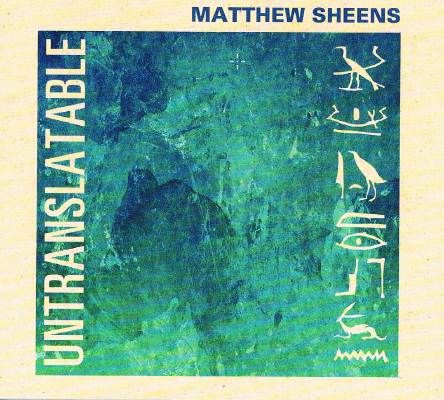 | Mathew Sheens - Untranslatable (Independent)
|
Since leaving Adelaide to study for a Masters at New England Conservatory, Boston, USA in 2009, having graduated with a Bachelor of Music from the Elder Conservatorium, pianist Mathew Sheens, predictably, has gone from strength to strength. Now, as a follow up to his acclaimed 2013 release Every Eight Seconds, this new album was also recorded in New York
The new collection Untranslatable, continues the pianist’s compositional excursions into semi-classical forms, utilising the Yanni Burton string quintet on four tracks blended into swinging interludes from piano, bass and drums. Sheens’s other interest, also evident in the previous album, is the inclusion of vocal arrangements flawlessly performed on both albums by ex-Portuguese vocalist Sara Serpa in mostly wordless mode. Two other performers from the earlier album are also present: bassist Linda Oh and percussionist Rogerio Boccato. There are some fine guitar solos from Mike Moreno, especially a fast-flowing sequence, after a unison passage with the vocalist on Dépaysement. Male vocalist Michael Mayo appears on three tracks, including an impressive interpretation of the standard Old Devil Moon with just Sheens’s imaginative solo piano accompaniment
The Sheens original Madrugada tosses a Latin classical theme back and forth between piano and string quintet, interspersed with some quick bass patterns and adds an excursive guitar solo punctuated by percussion and Ken Walters’s drum kit. Another Latin piece Alfonsina y el Mar, by famed Argentinian composer Ariel Ramirez, is a sad tribute to the poet Alfonsina Storni who drowned in 1938, featuring Spanish lyrics delicately delivered by Serpa
There are two shortish Interludes on the album, both solo piano pieces suffused in classical influences. The title track opens with a staccato attack from the strings, soon giving way to the jazz trio’s rhythmic passage, but strings return to provide occasional backdrops and building to the quintet’s robust, rapid-fire conclusion
This is a most unusual and varied album containing elements of rhythmic jazz improvisation, semi-classical modes, and vocalists, plus a wide range of instruments. Sheens is a fine pianist capable of swinging solos and introspective moods, and his compositions show a high level of ability. His achievements are recognised by his inclusion as one of four finalists in the highly regarded 2014 Freedman Fellowship Awards
This year’s prestigious award was decided on August 20th in play-off concerts at the Sydney Opera House. The $15,000 prize, after lengthy deliberations in what was obviously a difficult decision for the three judges, was awarded to Aaron Choulai a pianist from Melbourne now living in Japan. Choulai intends to release a new album in October. The other finalists were trombonist Shannon Barnett from Melbourne, who spent time working in New York before being offered a full-time position in the WDR big band in Cologne Germany, and well-known Melbourne vocalist Gian Slater
   
|
John McBeath
Previously published in The Australian Aug 2014 |
| Back to Index |
| 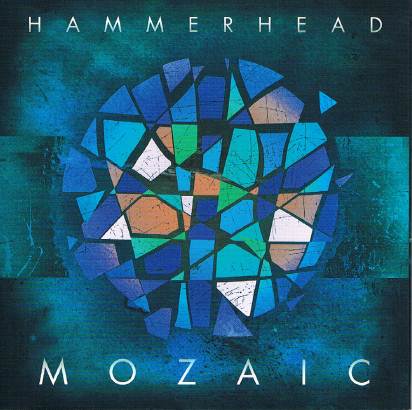 | Hammerhead - Mozaic (Independent)
|
Well-established Sydney saxophonist Jason Bruer fronts his skilled sextet for an album of re-arranged bop pieces from the sixties, plus several originals. Bruer’s brother Tim is on piano throughout and wrote the openerBlues of Many Hues with a strong trumpet lead by Ray Cassar in a blues that could have come from the repertoire of Nat and Cannonball Adderley
The title track, Cedar Walton’s Mosaic is taken at a brisk tempo, pushed along by Duncan Archibald’s crisp drumming and nicely integrated solo, Matt Gruebner’s dancing bass line, and Tim Bruer’s jabbing chords also adding a quick flowing solo. The tempo is appropriately slowed for Pat Metheny’s Sometimes I See in a languorous arrangement with a floating, lyrical alto solo from Andrew Robertson. It’s a straight ahead bop sound for Wayne Shorter’s Speak No Evil, while Jason Bruer’s composition Wayne’s World in waltz time features the composer’s introspective tenor solo with leaps into the upper register, some driving piano and bass, and interesting voicings in the ensemble work
Another original, Art for Art’s Sake also captures attention for its motile arrangement with the trumpet, alto and tenor functioning concisely together and delivers well-constructed solos from bass, alto and trumpet. Butch & Butch by Oliver Nelson lifts the tempo giving free reign to the quick piano with fast ensemble inserts. This collection is in many ways retrospective, and while it reworks numerous bop standards, it’s intentionally not trying to break new ground, managing to re-create many of the sounds and styles of jazz in the sixties, an important era in the history of the genre
   
|
John McBeath
Previously published in The Australian Aug 2014 |
| Back to Index |
| 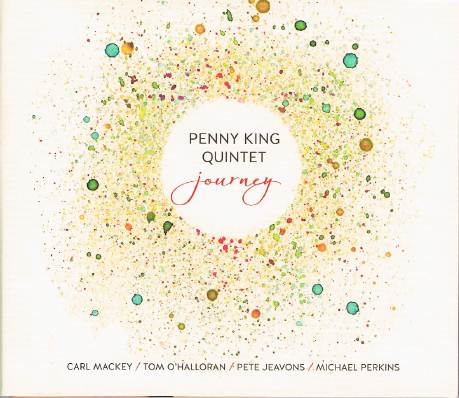 | Penny King Quintet - Journey (Independent)
|
Perth vocalist Penny King graduated from the WA Academy of Performing Arts (WAAPA) in 1996 and has been appearing with her band and tutoring in jazz vocals at WAAPA ever since. Accompanied by four of Perth’s top players King, a finalist in this year’s Bell Awards, has recorded an album of four standards plus five of her original compositions
The opener, and first of the standards – all arranged by King – is Bill Evan’s Waltz for Debby, starting with King’s solo voice and it features a pretty scat chorus to introduce Carl Mackey’s undulating tenor solo. Sonny Rollins’s Sonnymoon For Two opens with a scat chorus delivered with ease and followed by Pete Jevons’s smart bass solo. The title track Journey also begins with a short scat passage before King’s lyrics emerge against a Latin beat with embellishments from Tom O’Halloran’s piano
The complex Wayne Shorter standard Footprints also features a wordless chorus introduction and an impressive improvised passage ahead of fine solos from tenor and piano. The original Just You has a bluesy feel and features a standout barrelhouse piano sequence, as well as choruses both wordless and with lyrics, from King. It’s followed by an elegant and romantic ballad Together
The overall effect of this debut album is of a soft and gentle vocal style imbued with expressive phrasing and finely tuned pitch, combined with improvisational ability. A stronger, more forceful vocal approach would have added greater interest to a nevertheless pleasant sounding, relaxed and original album containing numerous effective instrumental solos
   
|
John McBeath
Previously published in The Australian Aug 2014 |
| Back to Index |
| 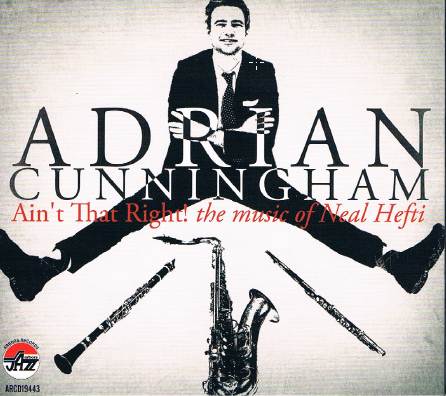 | Adrian Cunningham - Ain’t that Right! The Music of Neal Hefti (Arbors Records)
|
Sydney saxophonist, clarinetist, and flautist Adrian Cunningham took up residence in New York in 2008 where he’s since flourished and taken off for appearances around the globe. It’s easy to see why. He’s a highly competent musician and multi-instrumentalist. This album continues Cunningham’s immersion in a brightly polished mainstream genre. There’s nothing new here that couldn’t have been heard in the swing era of the forties, and composer Neal Hefti’s compositions provide a perfect vehicle
The opener The Odd Couple, sets the scene: accomplished playing, albeit with a heavy dollop of musical horse play, plus trombonist Wycliffe Gordon added to Cunningham’s quartet, as he is on three other tracks. Eight of the thirteen tracks feature the leader on clarinet and at times the clarinet, piano, bass and drums could easily be the Benny Goodman Quartet circa 1942
Cunningham moves confidently between tenor sax and the other two instruments on these familiar tunes. The tenor drawls lazily through Girl Talk, romps through Shanghaied, and swings commandingly into Cute. The clarinet moves quickly through a bluesy Gospel theme aided by Dan Nimmer’s piano on I’ve Got Love from Sex and The Single Girl while Ain’t That Right is given some fast flowing solos on flute. The flute also leads in a sprightly rendition of Suspicion the theme from a 1965 Jack Lemmon comedy How to Murder Your Wife. Die hard swing fans will enjoy this collection, and others, while appreciating Cunningham’s technical ability, may wish for more exploration and originality
   
|
John McBeath
Previously published in The Australian Aug 2014 |
| Back to Index |
| 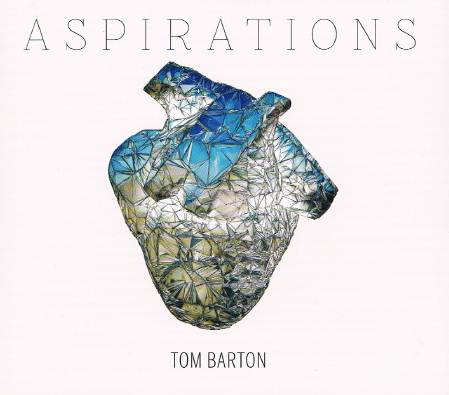 | Tom Barton - Aspirations (Independent)
|
This Melbourne release is a breakthrough in leading edge jazz vocals utilising original material, live effects processing, six top musicians, and the gifted approach of 28 year-old vocalist Tom Barton. A graduate from the Victorian College of the Arts, Barton studied for a Masters in Jazz Voice at New York’s Manhattan School of Music. The results on this debut album introduce the creative possibilities of 21st century male jazz vocals
One of two non-originals from the ten tracks is Bjork’s hit Hyperballad, taken at a slower tempo than the original, and against a subdued, sonic wash. All of the arrangements are by Barton, and some employ improvised loops of his own voice to great effect. There is some electronic augmentation throughout the collection and it fits perfectly. Barton’s voice is a soothingly smooth tenor, occasionally wordless – there’s some inventive scat on Vessel – but always with profound expression, drawing on historic examples of jazz singers but injecting his own personality and interpretations. In a mostly slower tempo collection, perhaps a couple of faster pieces might have been preferable
The backing is superb with standout solos from pianist Joseph O’Connor, bassist Philip Rex who co-produced the album, saxophonist Andy Sugg, and guitarist Stephen Magnusson. Spencer the Rover, a traditional song, is an unexpected inclusion, beautifully delivered. There’s a salute to indigenous music in Tjukurpa with sensitive, wordless vocals followed by a fast, vibrant, shouted chorus. Barton is joined by vocalist Georgie Darvidis for angular and then harmonised voices in Pearl Point. This album heralds the arrival of a unique new talent in Australian jazz vocals
    
|
John McBeath
Previously published in The Australian July 2014 |
| Back to Index |
| 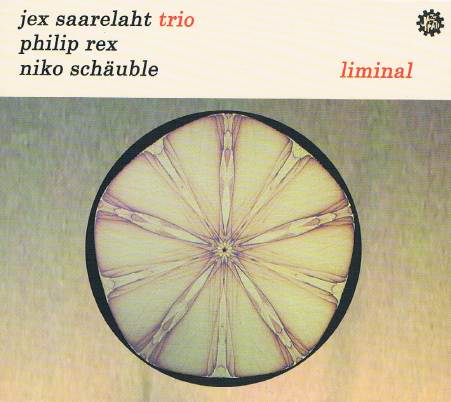 | Jex Saarelaht Trio - Liminal (Jazzhead)
|
Formed over twenty years ago by pianist Jex Saarelaht this trio, one of the most respected Melbourne small groups, has now released a follow-up to their 1999 double album, Fiveways which included saxophonist Julien Wilson. With long term associates bassist Philip Rex and drummer Niko Schauble, Saarelaht’s trio has added these six originals to his considerable repertoire. The opening track – conversely entitled Closing – is a densely chordal theme with an insistent rhythmic pattern interspersed with treble runs, soon giving way to a bass solo. The piano continues, working big chords into the assertive rhythm and weaving inspired, cyclical improvisation firstly behind soloing drums and then at the forefront.
The title track develops a rolling theme to introduce Rex’s solo with its skilful double and triple timing ahead of the piano’s flowing treble embellishments while Five Nineteen is a blues, opening with a bass cadenza full of high speed runs and intelligent ideas. When the piano arrives it is with a modal approach to the swinging bluesy theme, building the tension to introduce the break-out drum solo. A semi-classical opening begins Then Again as a slow pulse emerges and Saarelaht embarks on an extensive, tasteful extemporization. In a salute back to the earlier album Five Ways, the closing track embodies a quite nostalgic-sounding theme which takes up a strong rhythm, maintained by the bass’s reiteration throughout an energetic drum solo heading into a climax that draws a roar from the crowd in this live recording. This is a superbly integrated trio displaying an extensive musical mosaic, led by a masterful pianist
   
|
John McBeath
Previously published in The Australian July 2014 |
| Back to Index |
| 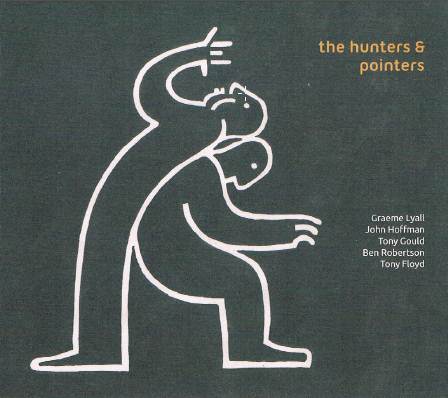 | The Hunters and Pointers - The Hunters and Pointers (Which Way Music/Fuse)
|
Recorded at The Limerick Arms Hotel, South Melbourne in 1991 this new release, 23 years later, qualifies as a ‘golden oldies’ collection for both content and performers. There are five lengthy tracks, all standards delivered in a mainstream style by a top talent Melbourne quintet of the time. The high level of musicianship is obvious from the beginning of the opener Just Friends, as John Hoffman’s trumpet interweaves with Graeme Lyall’s alto sax in an impressive, winding contrapuntal intro passage. A slow-building, brisk piano solo from Tony Gould follows, and then in sequence the pure, honeyed tones of Lyall’s alto, Hoffman’s well-constructed trumpet solo, the singing precision of Ben Robertson’s acoustic bass, and a smartly phrased solo from Tony Floyd’s drums
George Polyhronakos takes over the drumkit for two tracks, firstly Someone to Watch Over Me featuring a lyrical alto cadenza intro of beautiful construction extending leisurely into the ballad with just piano, sax and rhythm. I’ve Grown Accustomed to Her Face opens with unhurried piano roaming over the changes, sinking into an ultra-slow tempo for the sax to arrive in quickening exploratory runs backed by the piano’s well-placed chords and treble fills. Hoffman’s flugelhorn emerges for Freddie Hubbard’s Little Sunflower to harmonise attractively with the alto in the opening and later for an invigorating solo, sensitively exploring the melody before bursting into quick high register excitement. This grouping brought together some elite members of Australian jazz and the recording is a fascinating insight into their outstanding abilities at the time, musical attributes that still sound fresh after more than two decades
   
|
John McBeath
Previously published in The Australian July 2014 |
| Back to Index |
|  | Melissa Oliveira - In My Garden (Independent)
|
Australian born vocalist-composer Melissa Oliveira left to take up residence in Portugal and the Netherlands at the age of thirteen and embarked on extensive tertiary vocal jazz studies in Portugal and the US, completing a Masters in Jazz Performance in 2013 at the Royal Conservatory of the Hague. This, her debut album, was recorded in Boston with a piano trio of top-flight local musicians and five US and Portuguese guests. The opener is a tour de force interpretation of Wayne Shorter’s famous opus Footprints using Oliveira’s arrangement and lyrics. It’s immediately obvious that this is an ensemble production, utilising voice and instrumentation equally in a comprehensive presentation, and not merely a featured vocalist with backing. After a chorus of Oliveira’s lyrics and a passionate interlude from guest trumpeter Jason Palmer plus Will Slater’s bass solo, the vocalist returns with some inspired scat to conclude.
Flor Que Nao Dura, a poem by Fernando Pessoa, features the trio’s pianist Alexei Tsiganov on vibes and some finely sympathetic alto contributions from Greg Osby interspersed with vocal lines. Clifford Brown’s composition Sandu, includes Oliveira’s impressive vocalese, sounding slightly reminiscent of the great Annie Ross. An outstanding track from this most impressive collection in a Latin rhythm is Nat Cole’s 1948 hit Nature Boy, using Oliveira’s softly intelligent scat, Pedro Costa’s energetic piano, and the vocalist’s characteristic depth of expression combined with a great rhythmic feel, with or without words. Oliveira has completed a two-week national tour with her Netherlands quartet opening on July 26th at the Devonport Jazz Festival, Tasmania
    
|
John McBeath
Previously published in The Australian July 2014 |
| Back to Index |
| 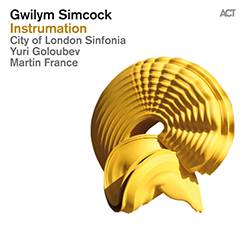 | Gwilym Simcock - Instrumation (ACT 9564-2)
|
The Welsh pianist and composer first came to the attention of Australian audiences when he toured with saxophonist Tim Garland in 2009. In Sydney, at the time, he was the talk of the town in the jazz world and with good reason. Since then he has forged his own solo career and is now being described in the same breath as Mehldau and Jarrett. Instrumation, however is just as much a showcase for his creative compositional talent as his pianistic ability. The album delves into two compositional stories; ‘Move’ which includes the City of London Sinfonia and ‘Simple Tales’ which continues the contemporary classical elegance with violin and cello. ‘Move’ is made up of three contrasting movements bridged by two piano interludes.
The album really is an epic journey that encompasses a variety of textures and themes from brooding introspection, traditional Welsh folk flavours to the excitingly theatrical. ‘Industrial’ the most compelling, has quite sublime moments interspersed with fusionistic guitar, brassy passages and driving rhythms underscored by an orchestral backbeat to die for. The Celtic folk ‘Dance’ utilises the violin of Thomas Gould and has you feeling like your changing partners in a square dance with its alternating changes and danceable melody. The rhythm section is made up of Martin France on drums and Simcock’s regular bassist Yuri Goloubev. Thoroughly recommended
    
|
Peter Wockner
|
| Back to Index |
|  | Daniel Susnjar - Su Su Nje (Independent)
|
West Australian-based drummer/composer Daniel Susnjar has recently returned from five years of performing and studying in the USA where he completed a Masters and Doctorate in Musical Arts at the Miami Frost School of Music. For his doctoral thesis Susnjar travelled to Peru to study Afro-Peruvian drumming and later assembled a group of top-shelf traditional and jazz players from the US, Australia, and Peru in New York to record this album of originals plus his arrangements of traditional pieces
Joining Susnjar there are ten other musicians on these eight tracks. The opener Enciendete Candela (Light the Candle) begins with a traditional acoustic guitar in uptempo 12/8 time adding Susnjar’s inspired rhythmic and melody-cognisant drumming assisted by the cajon box drum. Trumpet and then sax soon join in to state the catchy theme and Laura Andrea Leguia’s soprano sax solo perfectly captures the joyous Festejo mood before a brilliant break-out percussion display from Susnjar
A slow and sensual Lando rhythm in 6/4 time features a trumpet, tenor and trombone front line with Yuri Guarez’s acoustic guitar ornamentions and a stately solo from Alex Pope-Norris’s trumpet. This song’s title, Forte Pulse Torte, could translate as ‘Strong Rhythmic Cake’ which Susnjar says is an appropriate summation of his album and Afro-Peruvian music in general. Fearless Feel uses an unusual variety of instruments: trombonist Chad Bernstein blowing conch shells, acoustic guitar, cajon, and Susnjar scraping and shaking the quijada(donkey’s jawbone) in an uptempo Festejo rhythm
This unusual, imaginative album is an excellent introduction to a highly skilled exotic blend of jazz and Afro-Peruvian music
   
|
John McBeath
Previously published in The Australian June 2014 |
| Back to Index |
| 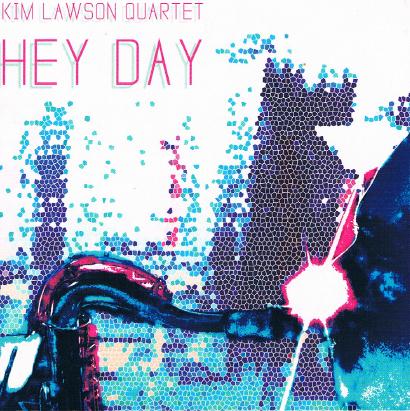 | Kim Lawson Quartet - Hey Day (Yum Yum Tree)
|
Sydney saxophonist Kim Lawson’s trio released their first album, Round The Bend in 2010 featuring bassist Steve Hunter and drummer James Hauptmann. The new album adds pianist Matt McMahon producing a tightly cohesive quartet of highly accomplished artists playing nine originals, six penned by the leader. It’s fitting then to entitle one piece, Welcome Matt which gives the pianist a wide free-flowing solo space during which at one point the sax provides a riff backdrop before embarking on its own energetic solo
The longest track, Moon Tune at just on ten minutes, opens in a vigorous slightly rocky, jumping sax theme, soon moving into an unaccompanied floating passage as Hunter’s murmuring bass arrives with drums establishing a changed tempo for raucous sax bursts and then McMahon’s keys wander eerily into a lunar landscape as a strong rhythm re-asserts and we’re back to the theme to close. By contrast the shortest track, at just over one and a half minutes, Edison’s Moth hurries along in fast, swirling bop runs, while another uptempo number, Jet Pack features the astonishingly quick fingering of Steve Hunter’s bass solo
Lawson plays both alto and tenor on this collection and Answer Theory makes awkward leaps on the alto sound easy and interesting as bass and drums busily keep an important sub-structure happening and McMahon throws in chords and a solo of bright movement. Led by Lawson, all of these players are of very high quality and they work together coherently, each member contributing equally to a high energy, polished collection
   
|
John McBeath
Previously published in The Australian June 2014 |
| Back to Index |
| 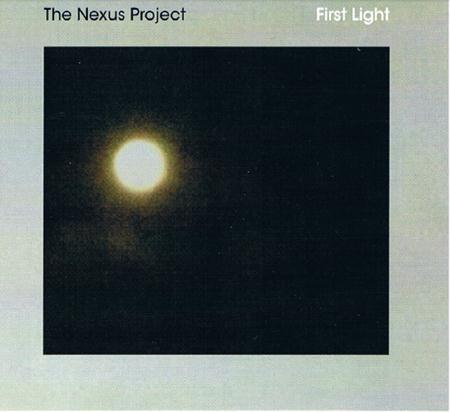 | The Nexus Project - First Light (Raincoat Records)
|
This first album by Melbourne trio The Nexus Project consists of guitar, modified bass, and percussion, a line-up that might have sounded more dynamically limited than the result the production has achieved. The effect is brought about by the sharing of melodic and harmonic role plus a small amount of electronic manipulation. However a certain similarity in the overall result does become evident across these eleven tracks. One piece that works well, Whirling Dervish uses Serge De Leucio’s percussive effects ably in an eastern-sounding number opening with James Wakeling’s guitar lead and Scott Dunbabin’s bass adding counterpoint before sliding into a rhythmic bass line and then taking the lead. The bass is specially designed and built by Dunbabin: it’s an upright six-string electric instrument with an acoustic chamber
The title track uses a leisurely acoustic guitar intro that subsides into supporting mode as it hands the vaguely familiar melody over to the bass, which later brings an altered tonality by using a bow. The opener, A Winter’s Breath begins with a sound that becomes repeated throughout the collection: an amplified bass lead, ornamented by guitar and percussion. A slightly classical influence appears in Falling Backwards with contrapuntal sequences between guitar and bass as drums take up a marching beat. There are classical echoes too in Danza, a strict tempo unsyncopated piece with stately guitar passages
These songs provide a number of pleasant-sounding, relaxing moments and attention is given to broadening the somewhat limited tonalities available. Nevertheless the collection at times does not completely escape a sameness of its admittedly unusual and intriguing ensemble sound
  
|
John McBeath
Previously published in The Australian June 2014 |
| Back to Index |
|
Melbourne International Jazz Festival
Various venues, Melbourne. May 30 – June 8 2014
MULTIPLE choices across several genres once again characterised the Melbourne International Jazz Festival this year. In addition to the ticketed performances across 24 venues there were free events, kids shows, masterclasses and artist interviews. But the program had a familiar ring to it: of all the headline acts, four of the overseas performers had appeared at the festival previously. While these are all outstanding performers, perhaps new alternatives might have been selected for exposure in Melbourne. Nevertheless it remains the largest jazz festival in Australia, with 80 performers from 12 countries and about 180 Australians.
Charles Lloyd’s trio, Sky, was a fitting opener for the festival. The multi award-winning US saxophonist, one of four headliners from abroad aged over 70, gave a strong performance of original compositions with superb backing from bassist Rueben Rogers and Eric Harland on drums. Lloyd mostly played tenor saxophone with his trademark runs of mercurial melody embellishment, but also took up flute and a reedy tarogato, a Hungarian reed instrument sounding like a cross between a clarinet & soprano sax. He later sat at the piano, playing rippling notes as he murmured a spiritual recitation. The trio appeared on another night with Greek vocalist Maria Farantouri, a long term collaborator whose soaring contralto on traditional pieces and Theodorakis compositions was successfully infused with jazz influences.
Inverting Jelly Roll Morton’s famous line about the Spanish tinge needed in jazz, saxophonist/flautist Jorge Pardo cleverly brought a jazz and blues tinge to Spanish flamenco. His Melbourne support group was bass guitarist Christopher Hale’s quintet plus three voices and featured show-stopping Spanish dancing by Johnny Tedesco. More intimate atmospherics were available at various club sessions, including drummer Allan Browne quintet’s major opus, The Drunken Boat, a picturesque musical narrative of Rimbaud’s poem interspersed with solos of high-level intensity. Another club session saw two Australians, pianist Paul Grabowsky and saxophonist Jamie Oehlers, team up with Harland, Sky’s drummer and bassist, for a sensational performance. During one Oehlers original, Paper Tiger, piano and bass fell silent as drums and tenor launched a missile that scorched across the room. Grabowsky’s beautiful ballad Angel then brought a drop in tempo and magical interaction between piano and the acoustic bass’s intricate solo. At another club, young Melbourne pianist Joe O’Connor played a selection of standards with his trio, including an unlikely version of Blue Moon given a highly inventive treatment with fragmentary references to George Shearing, Keith Jarrett and a touch of Thelonius Monk.
American vocalist Mary Stallings didn’t quite justify the New York Times accolade as “the best jazz singer alive”, though she presented an enjoyable evening of standards in a style that evolved from Sarah Vaughan and Billie Holiday. Displaying perfect pitch across a wide range, imaginative phrasing, and the ability to hold a very long and very high note, her most sensitive interpretation came in All Night Long. Not bad for a 74 year old.
Veteran Sydney pianist Mike Nock revived his duo with drummer Laurence Pike to improvise and explore in a completely impromptu session. Neither player led: it was an abstract, spontaneous duopoly, sometimes with faint classical echoes, with Pike’s ornaments, accents and punctuations set alongside Nock’s expressive piano improvisations.
Melbourne saxophonist Julien Wilson won three prizes at the Bell Awards last month, so expectations were high for his quartet — and they delivered mightily in one of the best performances of the festival. Wilson’s luscious, after-midnight toned tenor swung into Duke Ellington’s bluesyThe Feeling of Jazz for a mood-setting opener. New York based pianist Barney McAll, bassist Jonathon Zwartz and drummer Allan Browne all fitted the genre perfectly: old school influences in an intelligent, modern context.
British pianist Django Bates performed a celebration of Charlie Parker compositions, with his acclaimed trio Beloved fronting the 14 piece Monash Art Ensemble. It was a festival highlight combining Bates’s complex arrangements and his lightning fast incisive piano technique.
The festival’s conclusion came on Sunday night in a near capacity Hamer Hall with the long-established duo of two legendary players, pianist Chick Corea and vibraphonist Gary Burton. Like two electrons orbiting a musical nucleus, they played standards and several originals, including compositions from their new album Hot House. In uptempo tunes the notes flew with astonishing rapidity. Burton, a pioneer of the four mallet technique on the vibraphone, showed his masterful abilities as Corea supplied bass lines, chords and Art Tatum-like runs. Corea’s Mozart Goes Dancing set ideas from the Austrian composer in a jazz format before a semi-classical finale.
|
John McBeath
Previously published in The Australian May 2014 |
| Back to Index |
| 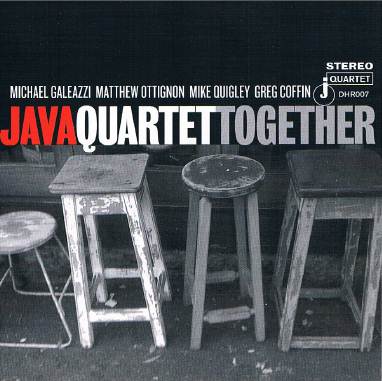 | Java Quartet - Together (Vitamin Records)
|
Over their 20-year existence, this Sydney quartet has attracted a loyal following and this latest recording brings their album total to seven. After the group’s 2010 release Rejavanation which experimented with digital beats, and electro-jazz, this new collection is a return to Java’s more familiar territory of acoustic contemporary jazz. All compositions are by bassist/leader Michael Galeazzi. There are five tracks of the quartet, with tabla virtuoso guest Bobby Singh adding Hindustani-style rhythms on two of these, plus two bonus tracks adding Singh as well as spoken word interplay from solo wordsmith Morganics
An ultra-slow ballad Maria features an introspective solo bass opening with eastern modality, followed by some lusciously lyrical tenor saxophone from Matthew Ottignon before a break and the tempo lifting as tablas arrive and Greg Coffin embarks on a soul-infused piano solo. Bass, piano and tabla introduceTiramisu for Ottignon’s reiterative theme statement, another piece with eastern tonality
Inspired by Radiohead’s The Pyramid Song, the opener entitled The Hill Song, is established by a short duet of bass and Mike Quigley’s drums with the latter coming strongly to the foreground in the closing chorus. Time Binders is a soul-fuelled piece with a heavy beat giving Ottignon the opportunity to provide a lift-off solo of vigorous intensity, followed by an equally developed one from Coffin’s rollicking piano
Of the two bonus tracks Pick it Up is the livelier with its tabla-assisted rhythmic sparkle. Morganics’s spoken words on both numbers are delivered in a jazz-poetry style which can be thought about as an additional instrument in the ensemble
   
|
John McBeath
Previously published in The Australian May 2014 |
| Back to Index |
| 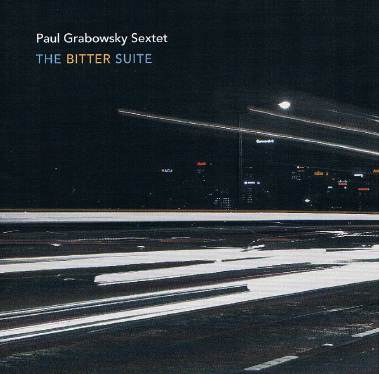 | Paul Grabowsky Sextet - The Bitter Suite (ABC/Universal)
|
It’s a tribute to the composer’s prodigious talents, and a source of wonderment, that Australian jazz legend Paul Grabowsky wrote and scored these eight originals plus an arrangement of a classical piece in an ‘urgent tumble’ of just a couple of weeks. He says the music draws on everything from the Rolling Stones to Rachmaninoff with fluid, rhapsodic solos and tight rhythmic grooves
The non-original is an arrangement of Scriabin’s ‘strange and beautiful’ Piano Prelude Op. 74 with a stately and mysterious solo piano introducing an intriguing, saggy, dragging ensemble theme topped with Andrew Robson’s soprano saxophone. The opener Paradise also has a classical connection with quotes from Brahms’ Symphony No.1, in a jaunty medium tempo contemporary piece featuring piano solos that achieve flowing classicism and brief elements of dissonance in a swinging framework; amongst the precise group work, James Greening’s conversational trombone seizes attention
Cameron Undy’s bass swings in to open Try The Veal, with the piano’s gentle chordal assistance, before the ensemble arrives with Robson’s alto leading and then soloing lyrically in a ballad style number, preceding the authoritative tenor of Jamie Oehlers, Greening’s declamatory trombone, and a swiftly moving bass solo. An up-tempo, post-bop Vexatious showcases Simon Barker’s quickly intelligent drum work, plus the saxophonists’ and muted trombone solos all underscored by Grabowsky’s always important but never controlling piano.
Bringing together some of the strongest players on the Sydney jazz scene, plus Oehlers from Perth, this album, one of Grabowsky’s best, features inspired solos, rich complexity and often a silky smoothness, in superb interpretations of imaginative compositions
    
|
John McBeath
Previously published in The Australian May 2014 |
| Back to Index |
| 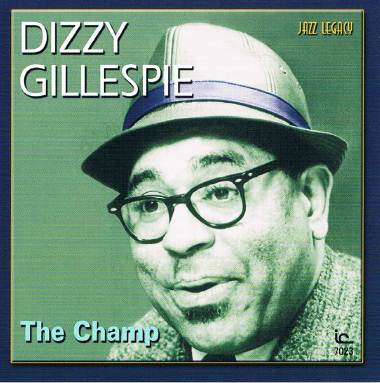 | Dizzy Gillespie - The Champ (Inner City Records/Planet)
|
This re-issue, recorded live in Paris in 1953, is one of the masterworks by trumpeter John Birks ‘Dizzy’ Gillespie (1917 – 1993) and perhaps his last featuring the legendary artist on a straight trumpet before he converted to his signature instrument with its forty-five degree upturned horn. Bop was in its infancy in the early fifties and it’s enlightening to hear one of the genre’s famed inventors delivering the new style, leading an all-American quintet plus vocalist Joe Carroll
As in most of Gillespie’s live performances there are excesses here, as well as excitement, and both appear in the tear-away title track opener. Excitement mushrooms as Gillespie takes off in a speeding solo of searing intensity, then lapses into a nonsensical bop talk vocal by Caroll and Gillespie. There are other fine solos by bassist Lou Hackney, Bill Graham on baritone sax, and pianist Wade Legge
One of several standards, On The Sunny Side of The Street gets the bop treatment and more vocal clowning while Good Bait gives Gillespie the opportunity to slyly quote from more than half a dozen other numbers, between high-frequency cascades of flying notes. A medium tempo blues is energetically worked over by Gillespie’s Harmon-muted trumpet in Birks Works
Another legendary trumpeter, Chet Baker is also being re-released by Planet – his 1979 album with a trio, Broken Wing containing Baker’s fine performance ofHow Deep is The Ocean. It’s great to see these two historically important albums being re-issued, providing an opportunity for those perhaps unfamiliar with these stellar figures to listen to some great music from the past
    
|
John McBeath
Previously published in The Australian May 2014 |
| Back to Index |
| 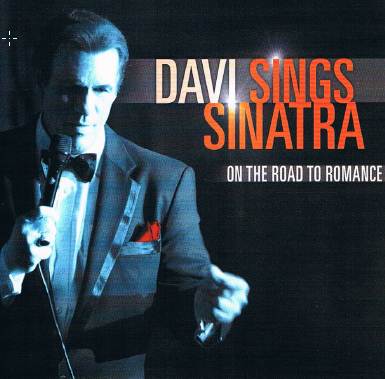 | Robert Davi - Davi Sings Sinatra (ABC Music)
|
American singer and actor Robert Davi – Die Hard, Licence to Kill etc. – has been a long term fan since he appeared with his idol Frank Sinatra in the 1977 television drama Contract on Cherry Street. This collection of twelve of Sinatra’s best known songs, features similar arrangements by Nic Tenbroek to those iconic ones by the gifted Nelson Riddle, complete with copies of Riddle’s string sections. Nevertheless these re-interpretations can only be a runner-up to the inspired originals. This is true of copies of all 20th century greats – Bing Crosby, Billie Holiday, Ella Fitzgerald etc. – because improvement in a straight out copy is not an option; their inimitable original works are the reason for these artists’ enduring fame. Davi, who’s booked to appear at the Melbourne International Jazz Festival on June 7th, does a competent vocal job, copying Sinatra’s phrasing and style, but the maestro’s legendary depth of emotional feeling and belief in the lyric is not equalled here. Comparisons are inevitable and Davi’s voice is pleasant enough, occasionally sounding similar to Sinatra’s unique tonality in the ballads All The Way and In The Wee Small Hours of The Morning or swinging through Day in Day Out and I’ve Got The World On a String. Hearing these, and other Sinatra classics from the fifties and sixties, such as Too Marvellous for Words or Witchcraft, will be a nostalgia trip for many, and may cause some to seek out the originals for comparison. Perhaps though for all copyists there’s advice in the lyrics from one of these songs, Nice n’ Easy: “The problem now of course is/ to simply hold your horses/ To rush would be a crime. . .”
  
|
John McBeath
Previously published in The Australian May 2014 |
| Back to Index |
| 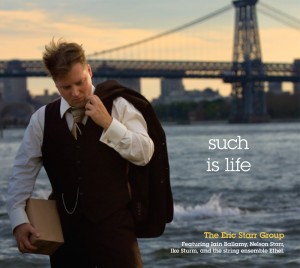 | Eric Starr Group - Such is Life (Independent)
|
From commotion to lost and frustrated love, ‘Such is Life’ presents an anthem from the theatre of life through the thoughtful lens of Western New York drummer Eric Starr. The group he leads is made up of brother, vocalist, pianist and guitarist Nelson Starr, UK tenor player, Ike Sturm on drums with trumpet, French horn and at times saccharine string arrangements nestled into Starr’s original tunes which are ripe for harmonic invention. The follow up to 2003’s ‘She’ for the Eric Starr Group is in its element when tunes such as ‘Can Spring be Far Behind’ focuses its cohesion as a straightahead bop unit. It opens with a textural solo drum intro before the group presents the harmony friendly head in classic ‘Blue Note’ style before talented pianist Nelson Starr’s predominant right handed but sparkling solo makes way for an inventive but audibly evident overdubbed guitar solo also by Nelson Starr. Iain Bellamy’s bright tenor then solo’s over the woody Ike Sturm bass before leaving Starr some more solo space prior to returning to the head. An album of Starr’s originals, the diversity in arrangements, feel and flavour coalesces into the ‘life’ concept with beauty and precision in a laid back, late night New York soundscape
  
|
Peter Wockner
|
| Back to Index |
East Coast Blues & Roots Music Festival (BluesFest) 2014
The 25th Blues Fest. How can I describe it in words? Perfect weather, screaming high pitch bended guitar notes, a young sexy woman with sultry voice rhythmically moving in front of a mike (no, I’m not dead yet) and thousands of very friendly and happy people all around you. Does that do the trick? I don’t think that it is possible to capture the vibe of the Festival with words alone. Even so, I will try to sketch out for you what it was like at the gigs that I most enjoyed. I will be focusing on Australian and young musicians (you can read Wikipedia about international mega-stars :-)
This year’s festival, in my view, was ladies’ festival. Beth Hart, Grace Potter, Cara Robinson, India Arie, Kasey Chambers, Genevieve Chadwick, Nikki Hill, Pat Wilder, Trixie Whitley, Candy Kane – they played the most memorable gigs.
Thursday 17/4/2014
 |
 |
7:15 JAMBALAYA. “Playing For Change”
“Playing for change” is not just a band name – it is a movement. This movement describes itself as follows: “Playing For Change is a multimedia movement created to inspire, connect, and bring peace to the world through music.”
|
Started 12 years ago, it became wildly popular after their clip “Stand by me” – recorded by different street musicians from all over the world – went viral on youtube, gaining over 60 million hits. Today, these musicians (from 31 countries) have come together to travel the world to promote their message. They sing and play in diverse styles, rhythms and languages. Usually at a concert, you can judge a performance by the amount of attention that the audience is actually paying to the performer – the amount of white noise coming from the crowd is generally a pretty good indicator of this. I’ve never experienced such palpable silence in a crowd of several thousand as I did when an old blind musician from the streets of New Orleans – Grandpa Elliot – sang a-cappella Down by the Riverside.
Friday 18/4/2014
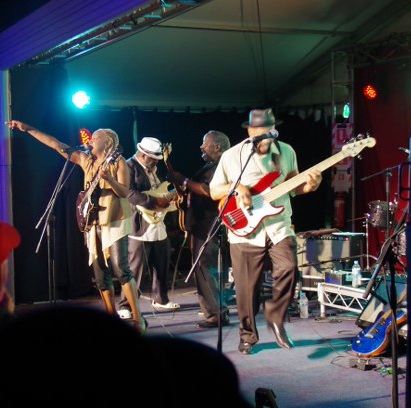 | 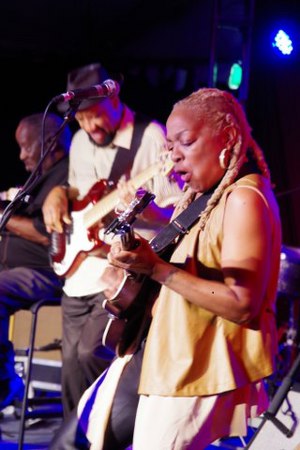 |
3:30 JUKE JOINT. Music Maker Foundation
This is an interesting one. The Music Maker Relief Foundation was founded by Tim and Denise Duffy 20 years ago to (in their own words) "help the true pioneers and forgotten heroes of Southern music gain recognition and meet their day to day needs.” It relies on donations (from B.B. King, Eric Clapton, Taj Mahal and others) and the proceeds from records of not very well known musicians.
|
A few years ago, Foundation created a touring band made up of musicians who represent various styles of Southern Blues. They were our guests at BluesFest and, this time, they were joined by Pat Wilder – a tight, rough bundle of energy with a strong voice, meteoric movements and magic electric guitar licks. As Pat herself told us, “my purpose is to create more love and involvement between people throughout the world with music” – and she does it with deep conviction and style.
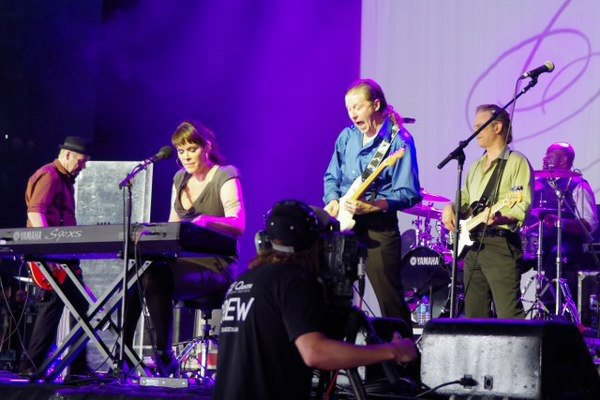 | 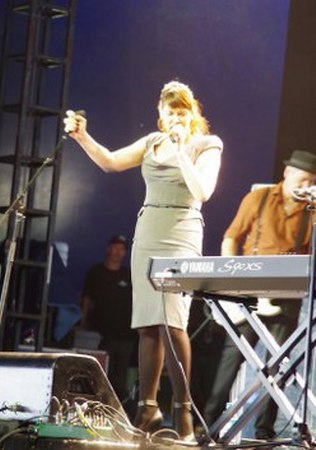 |
3:20 CROSSROADS. Beth Hart
Talented to the extreme, fighting (and winning!) her own demons after years “at the bottom” and a miracle-husband to keep her out of trouble (“he took me in, fed me and loved me long enough to love myself")… It’s exactly this kind of brew that produces blues stars of such high caliber – not only does Beth have a great voice, she’s also able to use it to convey human
|
drama and emotion in its fullest depth. Singing and playing keyboard, she performed original songs from her latest album (Grammy nomination in 2013) and some great standards. The most memorable? - "I’d rather go blind”.
Saturday 19/4/2014
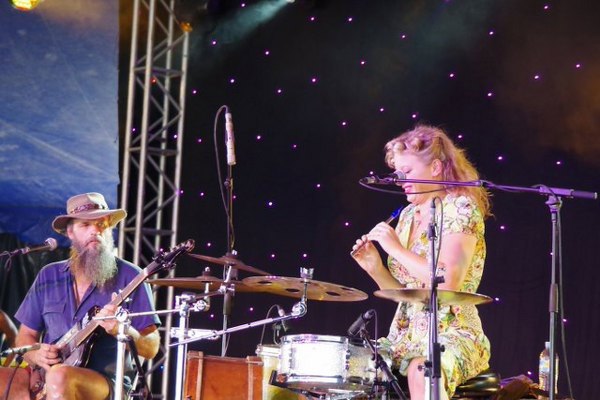 |  |
12:15 DELTA Hat Fitz & Cara
Aussie wild bushman Hat Fitz (performing at his 18th BluesFest – is this a record?) and the very Irish Cara Robinson. A very memorable duo: country blues masters; husband and wife. They sang blues, folk, old poems and original songs. Drums, guitars and flute. One of their songs “Power”, contained nothing but this one word repeated over and over – but you could really feel the Power around you when they sang.
|
Their music created a very close and warm atmosphere, which they seasoned with ad-lib jokes about everything – the public, themselves and Cara’s new dress (which, by the way, looked very good on you, Cara). Go and see them.
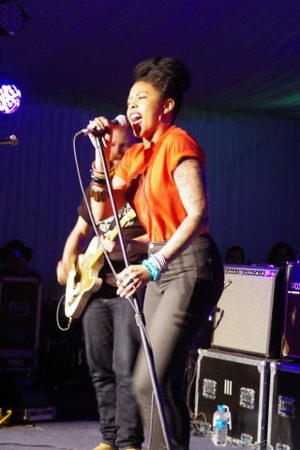 | 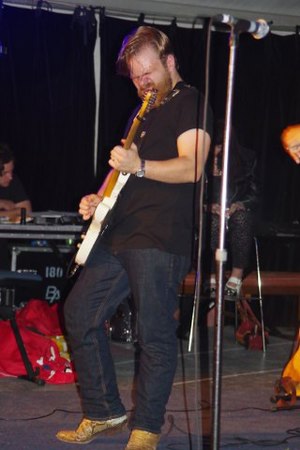 |
18:00 CAVANBAH Nikki Hill
Etta James and Otis Redding would be proud of this gig. Nikki Hill kept up her style, energy and intensity – all perfect – across all three of the gigs, bringing in a bigger and bigger crowd each time. Supported by a great band (which included her husband Matt Hill – one of the best lead guitars at the Festival) she performed Chuck Berry and Little Richard style old hits and her own original R’n’B and Rock’n’Roll explosions. All were very good and kept the audience moving, jumping and dancing
|
throughout. This is the beginning of a new star. Watch her rising.
Sunday 20/4/2014
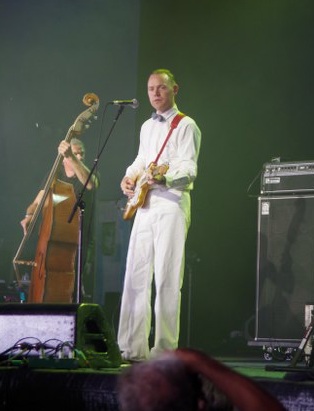 |
13:30 CROSSROADS C.W.Stoneking
This was the most stylized performance of this year’s BluesFest. Everything was strictly done in 1920s and 30s blues style (Robert Johnson comes to my mind): the look, the instruments and even the distinctively Southern drawl with which C.W. talked during and between songs. A man with quite a colorful bio (born in the Northern Territory, lived on all major continents, tired his hand at many professions, including assistant to a hoodoo doctor, farmer and handyman, survived a shipwreck), he keeps his dedication to old blues while exploring other styles (Afro-Caribbean Calypso).
|
My favorite was Jungle Lullaby from the “Jungle Blues” album. The first thing I did when I got home from this gig? I checked his website to find when he’s next playing in Sydney…
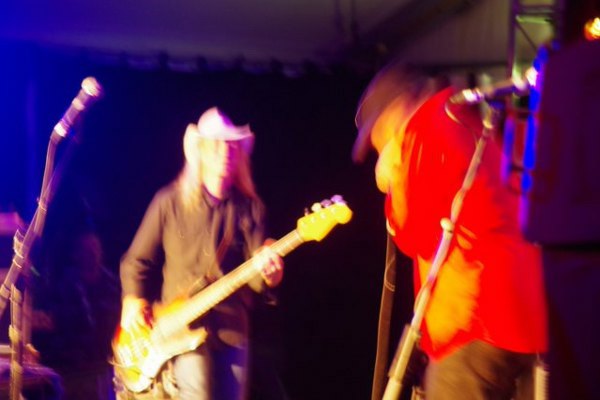 |
11:20 JUKE JOINT Chain
Chain – Matt Taylor (harmonica), Phil Manning (guitar), Trevor Draper (drums), Dirk Dubois (bass). Chain has its roots in the first ever Australian blues band, The Bay City Union (established in 1966). This is the only Blues band to have a No 1 hit on the Australian charts and a No 2 hit in NZ. It has released over 10 records and has a big group of dedicated followers.
|
Matt, the big front man, with his heavy Australian accent, low voice and his true blue Aussie jokes had you feeling as though you were sitting in your own backyard, drinking beers and singing tunes with an old mate (who just happens to have been No 1 on charts :-)).
Monday 21/4/2014
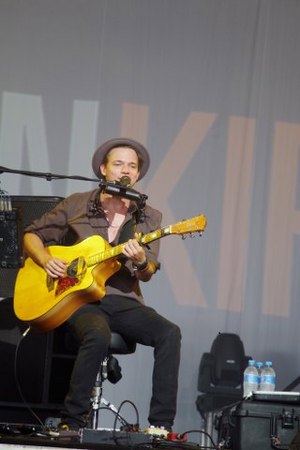 |  |
12:40 CROSSROADS Shaun Kirk
This was the Monday morning opening gig. Although it was on the major stage, not very many people initially showed up (have you ever seen blues fans getting up early?). A welcoming Melbournian, Shaun Kirk, was playing original songs accompanied by a pedal drum kit, guitars and a harp. Very fresh sound, deep lyrics and great chemistry with the audience. “Five years ago I was standing here, at CROSSROADS, watching Buddy Guy’s evening gig, thinking what to do with my life…
|
At that time I was working at the music store…quite boring stuff…Soon I quit and started to travel as a musician…Now I’m at the same place, but this time on the stage (smiles), playing a midday gig…and I’m doing things I like now…what will bring me the next 10 years?...I want to play here the evening gig (laughs)”. His gigs finished with hundreds of people in the audience – CROSSROADS was almost packed this time (at 1:30 pm!). I want to buy tickets to his 2024 evening gig now.
BUSKING STAGE
This was the ‘official’ busking area (many street musicians were playing and dancing all over the Festival ‘unofficially’). I didn’t get a chance to see all of them, but the most noticeable were
More info, photos and videos - and if you want to try your skills (and luck) next year - http://www.bluesfest.com.au/pages/?ParentPageID=2&PageID=121.
A few other general observations:
- With each year, the lyrics and themes of Bluesfest songs seem to be becoming more socially active and responsible. This year, several BluesFest musicians took the chance to hold an impromptu performance at the Bentley Blockade (60km from Byron) – an anti-coal-seam-gas mining protest site.
- This year’s organisers very successfully widened the stylistic boundaries of the festival to include Blues, Country-Blues, Indy, Rap, Funk, Rock and, contemporary music (in all of its various shapes and forms). This broadened the festival’s appeal, allowing it to run as a great family event where everyone, young and old, could find something to their taste.
- Three years ago, it was the vegan food stall that enjoyed the longest line of customers. Alas, this year it seemed to have none. This year, the longest queue (day and night) belonged to the take-away coffee shop. I’m intrigued by this complex sociological phenomenon...:-).
- On the negative side, it looks like BluesFest has outgrown itself. It has become too big (area and crowd-wise). Even the addition of another stage did not help much as about 18-20 thousand fans were coming through the gates every day. Maybe it is time to start a parallel SydBluesFest to keep Sydney-siders at home??
Some more names and photos – these artist definitely deserve your attention:
Round Mountain Girls - has nothing to do with mountains and girls. Great Australian folk and blues band.
Matthew Curry - 17 years old sensation from USA.
Chris Tamvoy– very talented 17 years old Torres Strait Islander.
Gary Clark Jr - new Hendrix?
Genevieve Chadwick - explosive singer/songwriter from the NSW South Coast.
Grace Potter and the Nocturnals - “a musically sophisticated young band inspired by the music of the late ’60s/early ’70s”.
And on a more serious note: Music, any music (especially folk, roots, and world music because of their accessibility and simplicity), being the only kind of art that is not based on representation of physical objects, talks directly to the hearts and souls of people (I have never seen people hugging a stranger at the movies or at an art exhibition :-)). It is very important to expose people to Music as much as possible (Mr Government, where are you?). It makes them better and kinder to each other. And BluesFest does exactly this – on a grand scale.
Be part of it.
|
by Vlad Gilbourd, May 2014
|
| Back to Index |
| 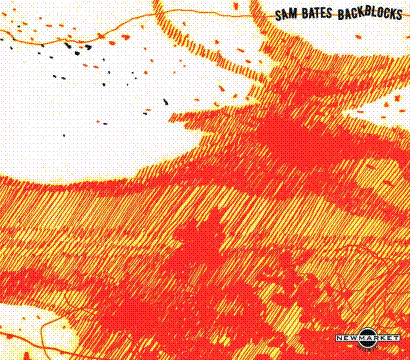 | Sam Bates Trio - Backblocks (Newmarket)
|
Melbourne drummer and composer Sam Bates’s trio released their debut album Singularity in 2010, and have now recorded this follow-up. Bates’s prolific compositions confirm an observation by US trumpeter Clark Terry that ‘most – not just many – most drummers play piano.’ And Bates couldn’t ask for two better interpreters of his music than outstanding bassist Philip Rex and the seemingly limitless capabilities of pianist Marc Hannaford, currently studying for a PhD at New York’s Columbia University.
While the style here is contemporary jazz, and there is plenty of solo work, a pulse, often a hard-driving one, is always present so that the music never strays into arrhythmic abstraction. A strong rapport between the players is always evident, giving the trio solid internal cohesion. The slow tempo and stepped repetition of Make It Stop are combined with a profound harmonic structure, used in all of Bates’s pieces, which Hannaford exploits beautifully in his thoughtful solo while the kit fizzes and punctuates.
The opener, He Who Laughs opens with spacey chords and a catchy theme as bass and drums smartly underscore and the piano begins a racing improvisation leading into a highly charged drum solo. A lop-sided drum beat introduces Rat Rescue for the piano’s bass end quirky theme, while Seaworthy uses Rex’s bass for the same purpose and later the bass adds its solo voice building to hyper-fast phrases. For its unusually interesting melodies, highly accomplished trio playing, and impressive flights of improvisation, this album is a worthy addition to the canon of Australian contemporary jazz
    
|
John McBeath
Previously published in The Australian April 2014 |
| Back to Index |
| 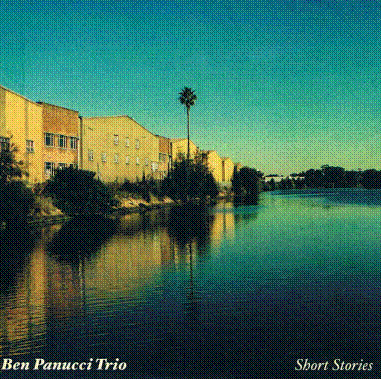 | Ben Panucci Trio - Short Stories (Independent)
|
The mood in this collection from Sydney guitarist Ben Panucci’s trio is mostly one of a softly, easy-going, after midnight style, exemplified in Lethargy Blues. That opening track, after a slow marching drum, meanders lazily in a Delta Blues way with the leader’s solo echoing traditional guitarists such as Robert Johnson, while Alex Boneham’s bass and James Waples on drums lay down an appropriate foundation. The tempo picks up for Party On The Event Horizon with Panucci’s guitar slashing out in multiple downward runs before Boneham’s inventive bass solo and Waples’s smart finalising drums. Waples’s solo track of a drum beat and jingling tambourine comprise Percussion, a piece of under two minutes.
There’s a vaguely Country and Western air to Old Themes, while A Dance opens with high treble guitar and tentative bass, resolving into a slow drifting melody. There’s a suitably murky beginning to Swamp Ballad, a slow tempo narrative number of melodic guitar – a descriptive evocation. The intriguingly entitled But Anyway It Isn’t a Game gets under way with interstitial guitar slowly building tension and effects and then subsiding into a pretty chordal progression brought to strong emphasis by adroit combinations of drums and bass.
Strummed ringing chords introduce Get Well, with fragmentary echoes of Eleanor Rigby, leading to more substantial chordal sequences of increasing intensity, ornamented by heavy punctuation from drums and cymbals employing repetitive, tremolo fades throughout. These nine compositions by Panucci are interesting original works, highly melodic, descriptive and well expressed, set in varied and thoughtful ways for guitar, bass and drums
   
|
John McBeath
Previously published in The Australian April 2014 |
| Back to Index |
| 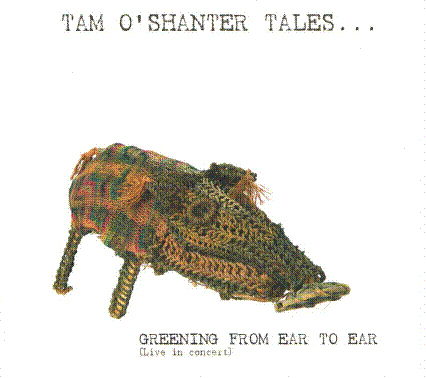 | James Greening - Greening From Ear to Ear, Tam O’Shanter Tales (Independent)
|
Sydney’s outstanding brass instrumentalist (mostly trombone) James Greening, has led and appeared in a great many important Australian jazz groups. Apart from his own combos The World According to James, and Greening From Ear to Ear, he’s been an important member of many top-flight ensembles including Wanderlust, The Australian Art Orchestra, The catholics, The Umbrellas and Ten Part Invention. This new septet album, an all-star line up of Sydney players, is so named because Greening composed these works amidst the inspiring landscape of Tasmania’s Bass Strait coastal community, Tam O’Shanter
The collection jumps into a lively opener, Parallel Lines established by Hamish Stuart’s sprightly drums aided by percussionist Fabian Hevia, and Greening soon takes off on an energetic trombone solo, followed by Andrew Robson’s free-running alto stoking excitement against the group’s energetic backdrop. Greening brings off an improbable sousaphone solo on a bluesy New Orleans stomper Lumpy, while Paul Cutlan adds tonal alternatives and fast flight on bass clarinet before the tempo doubles for Gary Daley’s swinging piano solo
After Brett Hirst’s bass line to begin Hazara, the leader’s pocket trumpet is pushed to high register ignition over a mid-Eastern rhythm later adding sympathetic accordion and a wildly explorative bass clarinet. Both mood and tempo are relaxed for the lyrical elegance of Sleeping Beauty introduced by dreamy accordion. It’s back to a trombone lead for another New Orleans bluesy style in Early Morning. These compositions, finely arranged by Greening, as with his solos, all encompass strong swinging beats and the skilful ensemble voicings often sound like a larger band
    
|
John McBeath
Previously published in The Australian April 2014 |
| Back to Index |
|  | Alex Stuart - Place to Be (Gaya Music)
|
Guitarist Alex Stuart graduated from ANU in 2005 and moved to Paris where he released his debut quartet album Around in 2011. This new collection retains saxophonist Stephane Guillaume on three tracks but otherwise Stuart has added three other French players for his current quartet: saxophonist Irving Acao, Chrisophe Wallemme on bass, and drummer Antoine Banville. Stuart has written seven of these eight tracks in styles that he classifies as ‘a real mix.’ It’s certainly that with the composer’s interests ranging from contemporary jazz, Indian classical music, African and Latin American styles and Indie rock. There are clues to most of those genres amongst these tracks: the sole external piece, Bjork’s Where Is The Line, features wildfire sax flying over a rhythmic rock riff followed by Stuart’s deftly speeding guitar.
The title piece has a strong, guitar-led African rhythmic feel as two saxophones supply an ornamented theme, leading into a duo breakout of fast-flowing sax and hyperactive drums, and then back to the ensemble intro theme to end. Pour Vous is a quieter number of a softly pleasant melody, gradually building with mysterious guitar chords and increasingly heavier beats as a sax solo lifts off and energises. There’s a deeply descriptive line to Snow Falling on The Crests of The Waves as sax and guitar meander calmly at first, slowly building enough tension for the sax to scramble into soaring high velocity mode. Stuart’s compositions are varied, evocative and interesting, arranged in thoughtful, composite ways while allowing sufficient freedom for effective solos
   
|
John McBeath
Previously published in The Australian April 2014 |
| Back to Index |
| 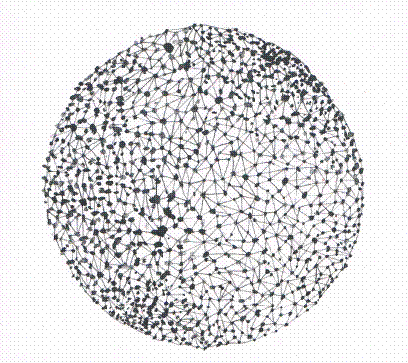 | Tilman Robinson - Network of Lines (Listen/Hear Collective)
|
This outstanding production involving twelve Melbourne musicians is in the grand tradition of a musical narrative, albeit without a libretto. The words and story are found in Italo Calvino’s 1979 metafictional classic If On A Winter’s Night a Traveller. This awe-inspiring work of contemporary music composed, arranged and produced by Tilman Robinson, who plays trombone and contributes laptop electronics, succeeds in portraying the literary work’s fantastical, postmodern story line of shifting viewpoints and random encounters
There is a symphonic jazz aspect to the work, sometimes featuring a brass lead of the two trumpets of Peter Knight and Callum G’froerer plus the leader’s trombone, elsewhere Beris Bilander’s piano comes to the fore, or perhaps strings appear courtesy of Erkki Veltheim’s violin and Judith Hamann’s cello. Drums and percussion by Hugh Harvey and Joe Talia are used throughout mostly to provide effects. Similarly Sam Zerna’s bass wanders with sub-structural precision. Occasionally there’s a free jazz similarity in these ten tracks
A joyously jumping riff opens Lines Enlacing gradually extended by Brett Thompson’s guitar as the ensemble arrives. The follow-on, Lines Intersecting, begins with a variety of abstract rustling and mysterious piano erupting into a fast staccato beat overlaid by brass with wah-wah mutes before subsiding back into mystery. The descriptive atmosphere and morbid tension created in track nine, Around an Empty Grave, is countered by the stately conclusion of the enigmatic final movement, What Story Down There Awaits Its End?
This eclectic label has again delivered an excellent recording of talented musicians interpreting a unique and memorable work
    
|
John McBeath
Previously published in The Australian April 2014 |
| Back to Index |
| 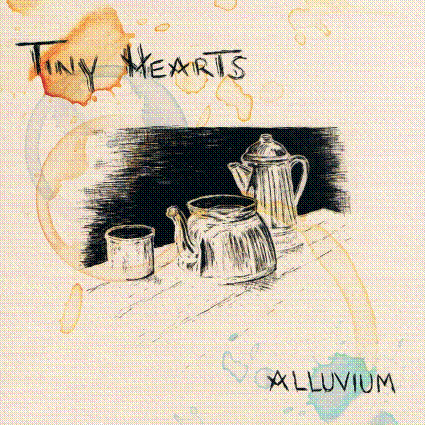 | Tiny Hearts - Tiny Hearts (Alluvium Records)
|
Sydney trumpeter Eamon Dilworth is a highly active musician. His quintet The Dilworths released their debut album in 2009, and then his gypsy ska quartet Caravana Sun album debuted in 2011, with a second CD arriving in 2013. In between Dilworth has toured extensively in Europe, and studied and played in the US, Australia and New Zealand, and won numerous awards. Not bad for someone who’s just turned 27
Now Dilworth together with drummer Paul Derricott has formed a new quintet, Tiny Hearts releasing a debut album of compositions by each band member. These pieces are described as ‘. . . tales of travel, searching, thinking of the cosmos, loss and identity.’ Five of the eleven pieces are by the leader, including the opener, Brief Stint which begins with a series of solo trumpet downward cadences, taken up by Dave Jackson’s alto as the ensemble arrives to slow things down, flatten out and then erupt into a raucous free-sounding sequence with accentuating drums. Pianist Steve Barry’s original, Kanji is a sumptuously pensive number carried by muted trumpet and alto with gracefully flowing piano ornamentation
There’s a vaguely familiar lullaby-style melody to Derricott’s Big Sea Reprise featuring wordless vocals from a trio of Elana Stone, Brian Campeau and the composer. Bassist Tom Botting wrote Balclutha, with an infectious tock-tock offbeat and stately harmonics. Cosmontology by Jackson is a post-bop piece – a term that applies to most tracks – with a long-note theme against jabbing rhythms adding the composer’s driving solo and an imaginative, tension-building piano sequence
   
|
John McBeath
Previously published in The Australian April 2014 |
| Back to Index |
| 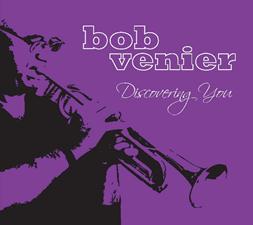 | Bob Venier - Discovering You (Independent)
|
Australian legend, trumpeter/composer Bob Venier (of Little River Band and Pyramid fame), has finally broken a recording absence of 18 years with this hot off the press release, Discovering You. Featuring a programme of eleven arrangements, seven of which are original compositions, and providing his own Tijuana Brass through dubbed trumpet and flugelhorn parts, Bob and his cohort of seasoned musicians have laid down some of the most beautiful music possible. The perfectly mixed and matched components of electric guitar and bass, drums, keyboard, congas and piano accordion provide the ideal accompaniment to brassy fanfares and liquid soloing. Time On My Mind is a great opener with its jaunty intro that immediately conveys an air of suspense, before Bob unfurls a burnished but mellow trumpet theme that seems to announce the next forty-five minutes is going to be something special. Tongue in cheek Aussieliana follows with danceable Latin rhythms and congas; staccato trumpets contrast magically against the solo flugelhorn, while later on, subdued muted trumpets intone a trace of light mockery as the flugelhorn returns. This is a veritable fantasia, brimming with melody and spiked with the full spectrum of brass timbre, with four open trumpets dubbed in pairs a semi-tone apart, creating a tight ensemble sound, and with flugelhorn and muted trumpets adding to the brilliance of the mosaic: (“Cop that!”, as he would say) and it is quite an endorsement for trumpet maker David Temby. The stunning Metta comes next with its plaintive flugelhorn melody but even more surprises are in store with the piano accordion of Roman Syrek on Concerto de Aranjuez (Adagio), Besame Mucho and Vestre’s Tune. Vestre’s Tune is indeed one to watch out for, essentially a duet of piano accordion and flugelhorn, Bob gives one of his most soulful performances placing the saddened beauty of this elegy right in the heart. The title track Discovering You completes the journey with its floating serenity and flugelhorn lines roaming freely through the ether. Among its many qualities (popular appeal, artistic integrity), this release has a first rate sound production and a wide cinematic embrace that would be ideal for film music. Forever the romantic, virtuoso Bob Venier has created a rare work of lyrical power.
CD can be purchased from ‘The Music Place’ stores in South Melbourne and Sydney
    
|
By Wayne Dawson
|
| Back to Index |
| 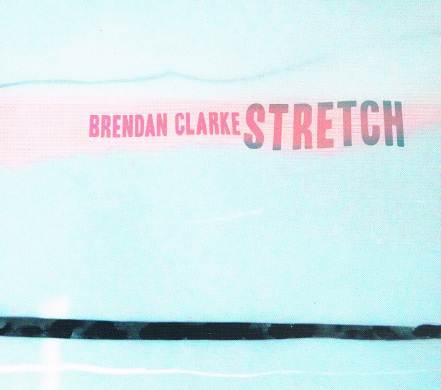 | Brendan Clarke - Stretch (Independent)
|
Considering Sydney-based Brendan Clarke’s long history of more than 15 years as a foremost bassist on the Australian jazz scene, appearing on over 40 albums, it’s a surprise that this is his debut release as a leader. Clarke graduated in Jazz Studies at the ANU Canberra in 1996 and that same year played at the prestigious Monterey Jazz Festival in California. Since then he’s played with such luminaries as Chris Potter, Maria Schneider, Dale Barlow, Roger Manins, Warwick Alder, Sandy Evans, Bernie McGann and many others. He has studied in New York, toured Japan, China, and Europe, played in Norway with the Jazzgroove Mothership Orchestra in which he’s been a long-term member.
This new album features Clarke’s sublime sense of swing heading a quartet with Dave Jackson on alto, Carl Dewhurst on guitar and drummer Andrew Gander. An album standout is the superb pairing of the acoustic bass with Dewhurst’s reciprocal guitar in rhythmic patterns, noticeable immediately on the opener Busline, where later Jackson’s alto winds sinuously as it gains speed. There are three standards in the collection, one Lazy Afternoon, dedicated to the late jazz vocalist Joe Lane, begins with Clarke’s relaxed melodic statement, and moves into Dewhurst’s serene guitar solo.
Another standard I’m getting Sentimental Over You also opens in a bass lead with soft guitar chords as Clarke moves into solo mode while maintaining his fine sense of pulse. There are echoes of Cannonball Adderley in Jackson’s uptempo alto on Clarke’s original Ride, and Gander’s drumming is showcased. The music doesn’t push boundaries, but the group fits together well and each member is an accomplished player
   
|
John McBeath
Previously published in The Australian March 2014 |
| Back to Index |
| 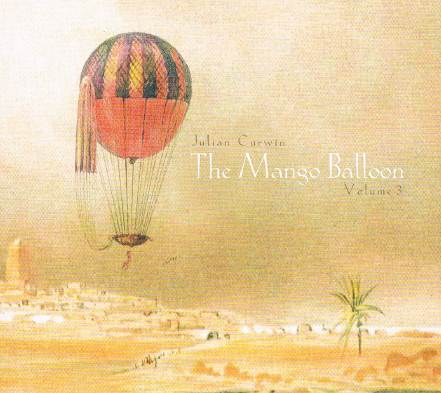 | Julian Curwin - The Mango Balloon Volume 3 (Romero/Newmarket)
|
Volume three of Sydney guitarist Julian Curwin’s The Mango Balloon, a stripped back version of his other band The Tango Saloon, follows the precedent on Volumes one and two of featuring a special guest. On volume three it’s violin and viola master Shenzo Gregorio. Musically the approach is similar to Volume two with its strong connection to Tango ideas and rhythms, albeit sometimes slightly bent. The collection is redolent of a lazy, sunny Sunday afternoon somewhere in Buenos Aires while guitar, accordion, piano, viola, and tuba plus a rhythm section languidly serenade a torpid audience.
Although billed as containing elements of Continental Jazz, the style is firmly melodic with few, if any, improvised solos. The opener Perdita sets the mood with Curwin’s Latino guitar meandering placidly. Marcello Maio’s accordion leads a waltzing High Noon – not the movie theme – and Gregorio’s viola sweeps into the theme on Cloud Town. Curwin’s compositions have a comfortable South American/Spanish familiarity and they’re all played with capable delicacy from the filigreed piano lead of Habanera to the oom pah pah tuba and trumpet waltz of Frijoles Negros, or another waltz, Wake in Flight, featuring a strict tempo accordion. A relaxed version of mariachi trumpet opens White Elephant followed by what sounds like a Hawaiian steel guitar.
By the final track Farewell, it’s not hard to envisage a mango balloon floating gently away to the accompaniment of a soft, chordal guitar and shimmering accordion. This is uncomplicated, accessible melodic music in a serene Latin approach which will have broad appeal for an easy-listening audience
   
|
John McBeath
Previously published in The Australian March 2014 |
| Back to Index |
| 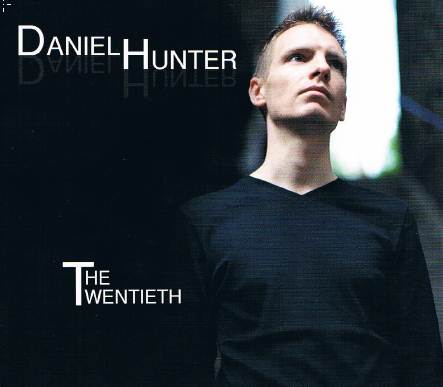 | Daniel Hunter - The Twentieth (Independent)
|
Guitarist Daniel Hunter graduated with honours in jazz performance at Canberra’s ANU in 2006, left in 2007 to teach and perform in Geneva for four years, before settling in Paris where this quartet’s debut was recorded. These compositions reflect Hunter’s travels including recollections of Canberra, the icy Swiss winter and his current home in Paris. Whilst the music incorporates a European aesthetic, particularly in the bass and drums work, Hunter claims flavours specific to Australian jazz and mentions influences such as James Muller and Miroslav Bukovsky.
The tracks are of rich harmonic movement and often contain bright melodies, well suited to Hunter’s bright-sounding guitar, displayed well in the opening to Trains. In that evocative piece there are travelling style solos from Warren Walker’s imaginative tenor sax and the leader’s guitar skillfully blending melody and chords. Born in The Eighties uses a guitar riff under a bouncy exuberant theme which the tenor explores cleverly and with mounting excitement. A more somber mood initiates Another Winter as an introspective guitar sketches a snow-capped vista and Damien Varaillion’s bass double times a solo over shivering cymbals.
The title track is a strong sax and guitar unison theme of vaguely bluesy origins with cheerful guitar fills before a brief gap and a break into a broken rhythm worked vigorously by Nicolas Charlier’s drums for swinging solos from guitar and then a tension-building tenor. A slow, steady beat starts the oddly titled Aaaaah in its soul-infused melody, an ideal vehicle for Walker’s flowing tenor. These are highly interesting compositions interpreted impressively and imbued with a taste of European lyricism
   
|
John McBeath
Previously published in The Australian March 2014 |
| Back to Index |
| 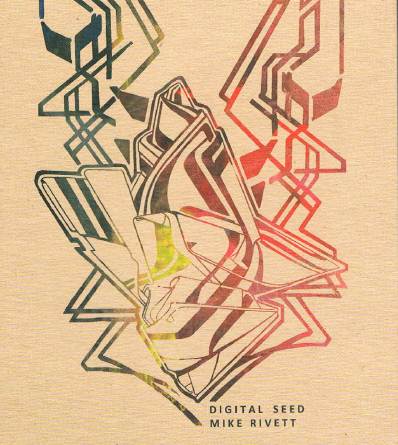 | Mike Rivett - Digital Seed (Primpy Records)
|
Ex-Cairns saxophonist and electronic music producer Mike Rivett is now Sydney-based and lectures at the Sydney Conservatorium, having studied extensively in the US and performed there, as well as in Europe and Japan. This debut album is a blend of acoustic and electronic sounds. One track, Staring Into The Sun, is compiled entirely by Rivett’s programming using his own playing of various woodwinds and additional synthesis producing pleasant harmonies and a slow, strong beat over a bobbing- along synthesizer sound. Other tracks use more conventional instrumentation of four to six personnel and some outstanding names: guitarist James Muller, bassist Alex Boneham, pianist Steve Barry, Ben Vanderwal on drums and several others.
Themes throughout are quite melodic and strongly rhythmic. The opener Cape Tribulation is a good example where a tropical sound is established with a Latin beat and Muller’s solo arrives to push it along, followed by the leader’s floating, then quickening tenor. The title track has a broken beat rhythm introduced by synth and bass against percussive effects to underpin travelling passages of unison Rhodes and sax by the leader. Sinister Nostalgia, another impressionistic piece utilising broken rhythms, has Rivett on clarinet, sax, flute, and synth while featuring Barry’s elegant contributions on Rhodes and a relaxing guitar solo from Carl Morgan.
The most invigorating sax work by Rivett is on Teriyaki Bowling where he also plays Rhodes, Wurlitzer, and synth. On the rhythmic side tracks have a broken-beat similarity but undoubtedly Mark Rivett is an accomplished composer and leader with an ability to employ electronics that do not stray into the overly abstract
   
|
John McBeath
Previously published in The Australian March 2014 |
| Back to Index |
| 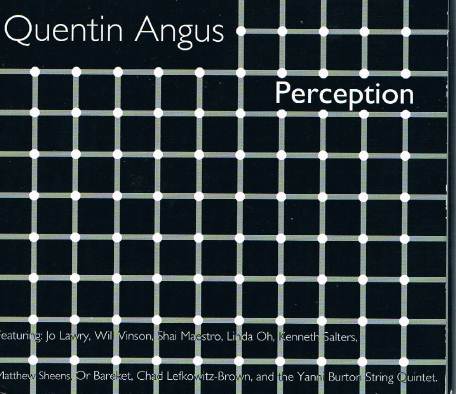 | Quentin Angus – Perception (Aurora Sounds)
|
Adelaide guitarist Quentin Angus, now New York based, released his debut album Retrieval Structure to wide acclaim in 2011. This new NY recording uses several players from the earlier album adding a string quintet on two tracks. Six of these eight pieces were written by Angus and demonstrate again his impressive creative abilities in composition. The title track opens with Shai Maestro’s piano flowing peacefully into a relaxed unison theme from guitar and Will Vinson’s alto. The number springs into a broken staccato rhythm established by Kenneth Salters’s drums, assisted by Linda Oh’s bass before returning to the concluding tranquil theme.
The string quintet makes its appearance for backgrounding sequences on Chernobyl, a composition by pianist Matt Sheens, a descriptive work of changing moods featuring Chad Lefkowitz-Brown on accelerating soprano sax and the leader’s imaginative guitar in a sparkling flight over the strings. Miles Davis’s Nardis utilizes active piano, a smartly moving bass solo from Or Bareket, and Angus’s skillfully referenced, high velocity guitar. The strings have a more pronounced role in Den Haag providing a sedate opening to introduce a relaxed rhythm through which the guitar floats pensively building gradually to Sheen’s energy-developing piano solo.
The closing track Bounce, another of Angus’s attention-grabbing compositions opens with a soprano theme, joined by piano and guitar adding tension, before intelligent, drum-driven guitar, and then soprano solos. This new album can only consolidate and affirm earlier opinions about the high level writing, production and performance displayed by this young guitarist. Quentin Angus is gaining a growing reputation in New York’s top quality jazz arena
   
|
John McBeath
Previously published in The Australian March 2014 |
| Back to Index |
| 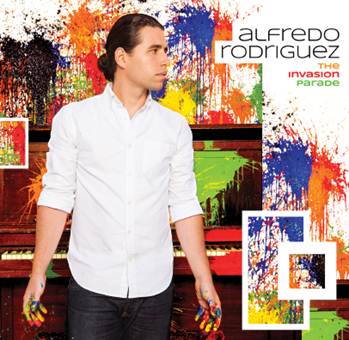 | Alfredo Rodriguez - The Invasion Parade (Mack Avenue/Planet Company)
|
Afro-Cuban jazz first emerged to the world in 1943 and received a massive boost when Dizzy Gillespie brought the style to New York in 1947. The genre, originally termed cubop, mixes jazz harmonies and improvisations with five-stroke African rhythms known as claves. Two of Afro-Cuban jazz’s foremost exponents Alfredo Rodriguez and Danilo Perez have new releases
Brilliant 28 year-old pianist, Cuban born Rodriguez, now New York based, co-produced his monumental work with Quincy Jones. The album title, The Invasion Parade refers to an annual event marking the end of Cuba’s war of independence from Spain. Amongst others the group includes US vocalist Esperanza Spalding, Puerto Rican drummer Henry Cole, and Bulgarian bassist Peter Slavov. The material is a mixture of Rodriguez’s compositions bringing a modernistic approach to traditional Cuban music and adding his interpretations of several Latin evergreens
The title track opens with a solitary soprano sax and then fast-rhythm congas and other percussion, moving like a joyous carnivale in Conga Santiaguera style to soprano and piano solos, the latter embodying contemporary classical aspects ingeniously interwoven into the Cuban theme. The standard Guantanamera is given a hectic atonal piano-led trio treatment with monstrous Stravinsky-like chords and fast arpeggios. Quizas, Quizas, Quizas, (Perhaps) another well-known Latin number begins with mysterious, dreamy piano treble quietly and slowly establishing a tangential melodic statement. The closer, Cubismo in a modern Cuban dance mode called Timba features a large group and vocal trio with Rodriguez’s amazingly adept piano in countering cross-rhythms
    
|
John McBeath
Previously published in The Australian Feb 2014 |
| Back to Index |
| 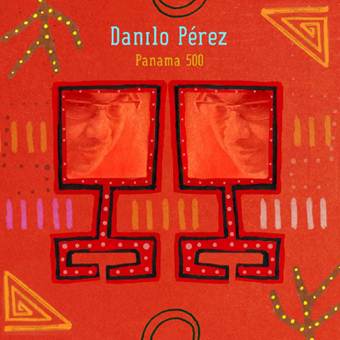 | Danilo Perez - Panama 500 (Mack Avenue/Planet Company)
|
Panama born, New York based pianist Danilo Perez’s album features two different trios plus violin, cello, two percussionists and a variety of Panamanian instruments. The first trio consists of Perez’s fellow sidemen from Wayne Shorter’s stellar Quartet, bassist John Patitucci and Brian Blade on drums; the second includes other long-term associates, bassist Ben Street and drummer Adam Cruz where the music expands on the idea of the clave. The album commemorates the 500 years since the Spanish crossing of Panama to discover the Pacific Ocean. Perez’s suite weaves together jazz and Pan-American folkloric traditions, tuneful set pieces, and improvisations with classical influences in a musical narrative
The overture Rediscovery of the South Sea portrays the Spaniards’ struggle through the jungle, including chants to invoke the indigenous Guna people and features violin and piano over various Latin beats in a musical narrative. The title track builds on the rhythms of La Denesa a traditional Panamanian dance, while the more serious Reflections on The South Sea adds a cello to underpin the piano’s flowing solo. The Canal Suite in three parts further extends the programmatic description of Panama’s culture and history
These two albums in slightly differing, but parallel ways, demonstrate the highest point in composition and performance of contemporary Latin jazz
    
|
John McBeath
Previously published in The Australian Feb 2014 |
| Back to Index |
| 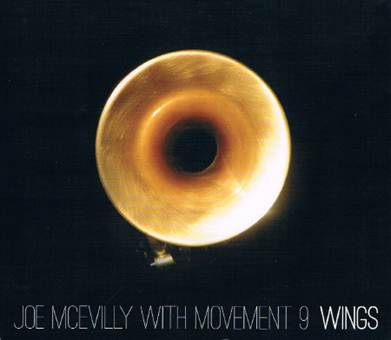 | Joe McEvilly with Movement 9 - Wings (Independent)
|
With so much attention devoted to the dominant Sydney-Melbourne musical axis it’s easy to overlook much fine music originating in other Australian cities, and this Canberra production is a good example. Baritone saxophonist Joe McEvilly, leader, composer and arranger of the nonet, and its personnel, were all studying at the ANU School of Music and an ANU grant funded production. Budget cuts later caused most members to relocate. There are guest appearances by School of Music lecturers, saxophonist John Mackey and trumpeter Miroslav Bukovsky.
The one track of the nine not written by McEvilly is John Coltrane’s Giant Steps featuring Mackey’s fast running, but not over-heated up-tempo tenor solo, and some superior drum work from Henry Rasmussen. The post-bop theme of Supercollider is a speedy opener where, after the ensemble’s statement Tate Sheridan’s high velocity keys are followed by Matt Handel’s equally quick alto, the smart electric bass of Rafael Jerjen and lively trumpet exchanges between Ax Long and Tom Sly.
The tempo is dropped right back for Siberia with its semi-classical piano beginning, and then picks up a medium rhythm from a bass and drum establishment for Oisin Smith-Coburn’s tenor solo to build intensity. Bukovsky’s impressively comprehensive trumpet in Siberia gives equal, finely considered importance to flourishes and spaces. The final track, Hip Abduction is the only one recorded before a live audience and it features a jazz-rock electric bass-driven riff rhythm with alto, keys, bass and ensemble all driving the excitement. This is a striking collection of notable compositions and arrangements by McEvilly and his youthful group is highly capable of performing them
   
|
John McBeath
Previously published in The Australian Feb 2014 |
| Back to Index |
| 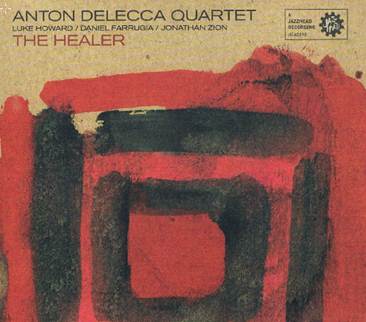 | Anton Delecca Quartet - The Healer (Jazzhead)
|
This third album from Melbourne quartet led by saxophonist Anton Delecca features eight originals and two standards. Delecca is well known for his quartet work and membership of soul-funk group The Bamboos; he’s also toured with several notable US jazz performers
The mood in this collection varies but mostly the style is bop-influenced mainstream, with some tracks featuring mid-eastern aspects. Each member contributes strongly, especially pianist Luke Howard. The opener The Ark has a mid-eastern modality, moving, after some intricate piano and tenor unison passages, into Delecca’s swift-running solo over substantial piano chords and mounting bass and drums rhythmic patterns. When the piano solo comes it’s heralded by Jonathon Zion’s staccato bass intro and soon builds its flowing sequence into an interesting melodic complexity. The Rogers and Hart standard Bewitched, Bothered and Bewildered is expressively phrased by Delecca and soloed on pleasantly by both piano and tenor. The other standard, Cole Porter’s Love for Sale features alternating straight four and Latin beat passages, established by drummer Daniel Furrugia and the solos are effective, but it’s difficult to find anything very innovative to say musically on such a well-worn piece.
The title track begins with soft, stately solo piano chords before bass and drums set up an eastern beat for the sax to join in with the melody and the quartet proceeds to its sombre, soulful piano conclusion. Sahadi’s delivers another mid-eastern style theme moving through minor intervals in a solemn procession to its subdued ending. This album is graciously listenable – especially the eastern influenced compositions – without any attempt at pushing boundaries
   
|
John McBeath
Previously published in The Australian Feb 2014 |
| Back to Index |
| 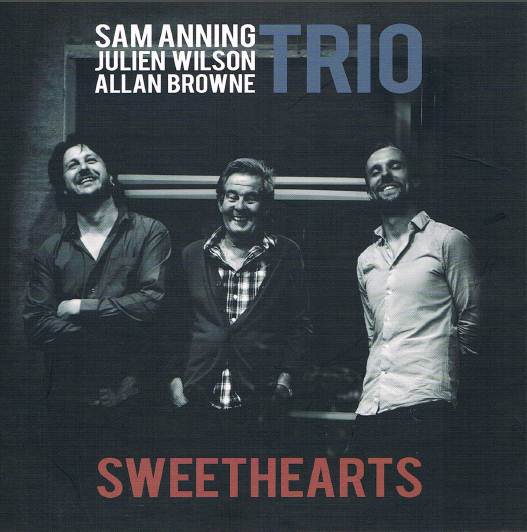 | Sam Anning Trio - Sweethearts (Listen/hear Collective)
|
|
Here is a trio that knows how to caress a tune but at times they press a little harder opening up no end of melodic explorations within a quasi retro context reminiscent sometimes of the late Paul Motian’s On Broadway sessions. Bassist Anning is joined by reedsman Julien Wilson and the omnipresent Allan Browne on drums. Anning contributes four originals amongst delightful memories by Walter Donaldson, Billy Strayhorn, Irving Berlin and Duke Ellington. Amongst the highlights is one of the pressing numbers by Anning ‘Princess Doug of Fitzroy’. Here Anning opens with a funky bass lick before Wilson states the melody on tenor, which is wonderfully spatial leaving plenty of room for the bass and Browne who simultaneously states the melody and the beat on the drums. Wilson’s tenor reaches further out within context before Anning contributes a fine solo. Elsewhere the disc’s dimensions are increased by Wilson’s soprano, clarinet and bass clarinet but it’s his beautiful Lester Young like tenor that shines often with sensually bent notes. No overdubs though, just solid heartfelt, spontaneous and glorious playing.
   
|
Peter Wockner
|
Each player in this trio is foremost in Australia on his instrument, although ex-Perth bassist Sam Anning has relocated to New York. Saxophonist Julien Wilson and drummer Allan Browne are long-term luminaries in Melbourne where the album was recorded. The eleven tracks are comprised of five pieces by Anning, one by Wilson and five well-selected standards. With the solo bass opening establishing a lyrical melody on track one, Anning’s Cactus Flower, two things are obvious: the beautiful resonance of the recorded instrument, and the consummate artistry of its player. Following that intro, shimmering cymbals preface the arrival of Wilson’s softly luscious tenor as Browne sketches an out-of-tempo mallets backdrop to produce a highly sensitive, beautiful ballad. The first of the standards, Little White Lies sets a swinging medium tempo from the start and as Wilson starts an absorbing, enmeshing solo and the bass walks to Browne’s impeccable beat, the effect is nearly transcendental. Wilson plays clarinet on his own composition Farewell, a slower tempo number with a pretty melody and a South of the border sound which he ornaments engagingly with assistance from a climactic bass solo. Soprano sax and bowed double bass in unison provide a noteworthy opening to Anning’s Through The Open Window and the bass clarinet makes an effective reprise of Cactus Flower. Wilson’s wide, warm tenor tone brings a lazy, sunny mood to Strayhorn’s Little Brown Book gradually strengthening throughout, and the horn’s lower register is put to excellent effect in The Best Thing for You is Me, followed by very smart and fast solos by all three. A virtuosic trio collection using interestingly varied instrumentation
    
|
John McBeath
Previously published in The Australian |
| Back to Index |
| 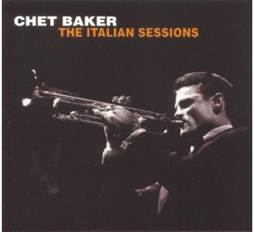 | Chet Baker - The Italian Sessions (RCA)
|
If you haven’t already heard Chet Baker’s Italian Sessions, recorded in Rome 1962, then you’re possibly missing out on his finest moment. There must have been hordes of first rate European musicians queuing for a shot with Chet during his five year stay but Renee Thomas, guitar; Amadeo Tommasi, piano; Benoit Quesin, bass; and Daniel Humair, drums; ran off with the cake. No vocals, just straight up bop encrusted melody making by this hot six with Bobby Jasper on tenor sax and flute. The shared soloing makes this a fine ensemble effort but there’s no doubt who they’re all there for. Chet soars the stratosphere with gleaming authority, setting the tone with a fiery clarion call and a programme involving some of Bebop’s main architects: Monk, Parker and Rollins. Well You Needn’t, Barbados and Pent Up House storm the barricades with everyone coming through unscathed, which is no mean feat in this pressure cooker. The balladry of These Foolish Things is as beautiful as ever. What was once described as the fragile vulnerability of Chet’s style has transformed with maturity into an emboldened agility in full creative flight before the corrosive consequences of drug abuse undermined a vital spirit. Great engineering from the RCA studios in Rome with remastered 20-bit super mapping providing lift: Unsurpassed booklet notes by Jim Macnie with plenty of photos makes this an essential release for any lover of creative music
    
|
Wayne Dawson
|
| Back to Index |
|  | Dexter Gordon - Blows Hot and Cool (Boplicity)
|
The legendary status of Dexter Gordon rests mainly on his Blue Note recordings of the 1960s but this one on the Boplicity label in the mid-fifties is well worth checking out: A quintet/quartet session including Chuck Thompson on drums, Leroy Vinnegar on bass, Jimmy Robinson on trumpet (tracks 1, 6 & 8) and featuring Carl Perkins on piano. The following year (1956) Carl would be a vital component to the Curtis Counce Group that would include Harold Land on tenor sax fresh from his stint with Clifford Brown and Max Roach. Harold would also make good use of Carl and Leroy on his masterful `In the Land of Jazz' session. It's interesting to speculate on what would have happened if Dexter hadn't gone for a second and lengthier skate in the big house on narcotics charges that took him out of the frame for pretty much the rest of the fifties. Imagine an active and invigorating Dexter working out of Los Angeles at exactly the same time as the Curtis Counce Group; the West Coast would have had an even stronger hand. Be that as it may, this is nectar of the Gods vintage Dex! It's startling to hear just how early on his conception of the tenor had come together (as early as the 1940's in fact). By 1955, when this was recorded, his mastery is total. Cry Me a River becomes a lamentation that could make the Grand Canyon resonate, yet fleetness of phrasing is employed just at the right moments to keep his line floating and what a line it is! Developed out of the melodious sideways movement of Lester Young but invested with the big tone of Coleman Hawkins yet free of his arpeggio dominance, Dexter brought this winning combination together and spiced it with tasteful pre-rock 'n' roll riffing, fused with the modern harmonies of Charlie Parker. All nine tracks are great alternating between hot up-tempo swingers like Rhythm Mad, Bonna Rue and Blowin' for Dootsie, with the cool grace of the ballads; this is legendary stuff and the whole band is on!
    
|
Wayne Dawson
|
| Back to Index |
| 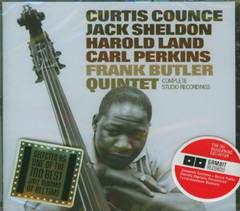 | Curtis Counce - Complete Studio Recordings (Gambit Records)
|
The Curtis Counce Group was one of those rare bands operating out of the West Coast that knew how to deliver a range of compositions defining the best of the fifties whilst remaining timeless. The material chosen always sits comfortably together whether it is standards, originals often including the blues, hard bop or popular pieces like Stranger in Paradise that immediately becomes exalted to a different plane once given their attention. Always fresh, harmelodic (to borrow Ornette Coleman's term, whose earliest two albums I think were influenced by this superb quintet), and potently delivered; Jack Sheldon's warm, mellow trumpet (that featured with many of the finest jazz vocalists at the time), alongside Harold Land's stiff and aching reed sound that is full of the most extraordinary articulations, has to be one of the most compelling couplings in jazz. Backed up by a rhythm section containing a pearl among piano players, Carl Perkins matches the inventiveness of Land's tenor sax providing swinging syncopations, balance and anchor, while Curtis Counce and Frank Butler on bass and drums back up the brilliance of the solos by sounding crisp and modern. The four albums originally released on Contemporary Records from the mid to late 1950s are remastered here on this double CD. It's a pity the Miles Davis band of the same period continues to absorb all the attention of those casually interested in jazz as The Curtis Counce Group is easily their match yet inversely neglected
    
|
Wayne Dawson
|
| Back to Index |
| 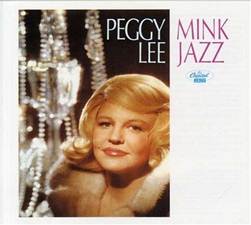 | Peggy Lee - Mink Jazz (Capitol Jazz)
|
Jazz vocalist Peggy Lee had a hypnotic sense of inner space. She could slow the ballads down to a breathless stillness like a shimmering apparition to a dream and bring lightness and shade, tenderness and introspection to a wide range of material. Mink Jazz, despite its cheesy title, was another quality release from her long list of inimitable recordings. Cut in 1962/63, what makes this CD release even more special are the five bonus tracks that are no mere fillers, but every bit the equal to the rest of the programme. For example, it’s hard to imagine her powerful version of I’m A Fool To Want You sitting on the shelf for all those years. So this represents the complete recordings to the Mink Jazz sessions. Bonus tracks aside, Whisper Not and Close Your Eyes are full of milk and honey swing, the trumpet of Jack Sheldon a perfect, delectable double. Ballads include My Silent Love, Days of Wine and Roses, I Never Had a Chance, Cloudy Morning and her own, Where Can I go Without You. The overall orchestration is very satisfying with tastefully chosen instruments like alto flute; guitar and piano spot lit alongside the featured trumpet of Sheldon and interspersed with Latino percussion. Another aspect to her style often overlooked but mentioned in the CD notes is her innate sense of swinging minimalism. Words are sparsely spaced along the lines allowing for lengthy silences making her, conceptually compatible at least, with trumpeters Miles Davis, Chet Baker and pianist Ahmad Jamal. Peggy Lee was also one of the few female singers who didn’t incur the lashings of Billie Holidays sharp tongue. Billie loved her and recognised Peggy’s individual talent as an exception to so many of her imitators.
    
|
Wayne Dawson
|
| Back to Index |
| 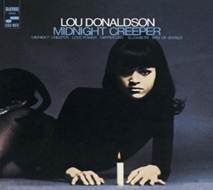 | Lou Donaldson - Midnight Creeper (Blue Note)
|
Lou Donaldson had already been in the centre of fomenting hard bop back in the early 1950s with Clifford Brown but by the time of 1957, this talented alto sax player of the Charlie Parker mold was already creating more mischief with blues riffed organ-sax combos that foreshadowed what would become the norm in the sixties. This canny operator spent a lot of time on the road in those days, touring from New York to Los Angeles and playing plenty of ghetto dance halls in between. Back then Lou had Grant Green on electric guitar, whom he considered a liability due to his drug habit as the whole band would've received hefty fines if they were pulled over by the police and he was busted. For this Midnight Creeper session recorded in 1968, we have the peerless line up of Blue Mitchell (of Horace Silver Quintet fame) on trumpet, alongside a very young George Benson on electric guitar. Often these kind of sessions can be swamped by too much juice from the organ but not with Lonnie Smith at the pedals and keys, who provides a boogie groove made anew by a rich curtain of tasteful chords. With Idris Muhammad on drums, these mid-tempo rhythms shunt along with satiable contentment, overlaid with the bitter-sweet tone of Lou’s alto, the pithy inversions of Blue’s trumpet, and the ravishing, ahead of the beat impatience of George Benson’s golden guitar lines. This is hard bop uncoiled into a loose, plush, funk, although Lou would deny calling his style funk, preferring the description “swinging-bebop”. Lou was a clean professional who didn’t drink or do drugs but kept his ear to the ground and read his audiences well, fashioning musical gifts for them that resulted in his biggest selling record, Alligator Bogaloo, recorded in 1967 and followed up with this gem, Midnight Creeper: Acid jazz eat your heart out! Dig the fold out cover!
    
|
Wayne Dawson
|
| Back to Index |
| 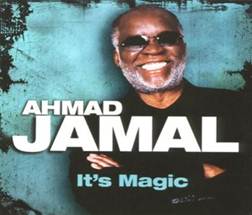 | Ahmad Jamal - It’s Magic (Dreyfus)
|
Boss jazz piano with a modern eastern flourish, Its Magic was recorded in France at the end of a European tour back in 2008. Ahmad has subsequently produced two more discs to critical acclaim using different personnel to these long standing members, but it's hard to imagine anything surpassing this. Although a piano trio with added percussionist, this is a full bodied sound that has a very physical presence to its delivery. `Dynamic' is a word used to describe Amad's playing (the first track is called `Dynamo') but it doesn't quite capture the impression that there's a bear of a man at the keyboard and he's been there for some time. Indeed, anecdote has it that Miles Davis used to take his band members around to listen to Jamal during the mid-fifties (at that time, Miles had Red Garland on piano). Miles appreciated the spaces and silences Jamal gave to the music. For such an incisive sketcher as Miles, he must have felt like a kindred spirit. The silences are still there but there's also plenty of beef on Jamal's chordal bones. Over half a century spent at the keyboard no doubt reaps a rich dividend and so it is with his choice of inversions and intervals, often harmonised from both ends of the Steinway, that leave a slightly disorientating, deconstructive effect on the mind. There's brilliant, introductory flourishes that bustle and give way to rolling lines of melody underpinned by a strong left hand (Swahililand); or pounding stabs at the rhythm that break off into raunchy melody and fragmented runs (Back to the Island). Drummer Idris Muhammad is another old soul who provided some of the best funk grooves back in the 1960s and bassist James Cammack swings solidly with a big tone. This is a heavy but uplifting gig that leaves some of the best till last with three superb pieces written and played while on tour and premiered as a recording on this production: Arabesque, Papillon and Fitnah are wonderfully evocative of the middle-east in a modern jazz context. Great music, great production!
    
|
Wayne Dawson
|
| Back to Index |
| 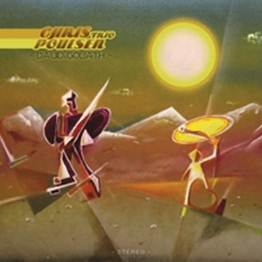 | Chris Poulsen Trio - David and Goliath (Independent)
|
On the funkometer scale, these original loping backbeats would peak against infectious classics such as Herbie Hancock’s Chameleon. The album is a modern day jazz concept of the biblical David and Goliath story. The swaggering ‘Brother Smell the Bread’ is based on the carrot dangled at David should he be able to kill the giant Goliath. The prize is the incentive of the kings daughter and tax exemption so no wonder this is the most alluring of all the tracks on the album. A simple enticing melody on electric piano applied with bluesy licks over a luscious Mitchell backbeat that gathers momentum akin to the irresistible lure of reward before O'Connor's funky fender bass holds steam allowing guest flautist Joshua Hatcher the opportunity to bring home the booty. Chris Poulsen is a Brisbane based pianist who clearly has been influenced by Hancock. He plays electric piano and synthesizers. The trio has been performing together for eight years and this is their fifth album. Other members of the trio are Jeremy O’Connor on acoustic and electric bass and Sam Mitchell on drums. I thoroughly enjoyed the energy they brought to a live set at the 2012 Manly Jazz festival and this studio album successfully reflects that energy with the added smattering of some wind and rain sound effects. The album artwork depiction is also by Chris Poulsen
   
|
Peter Wockner
|
| Back to Index |
| 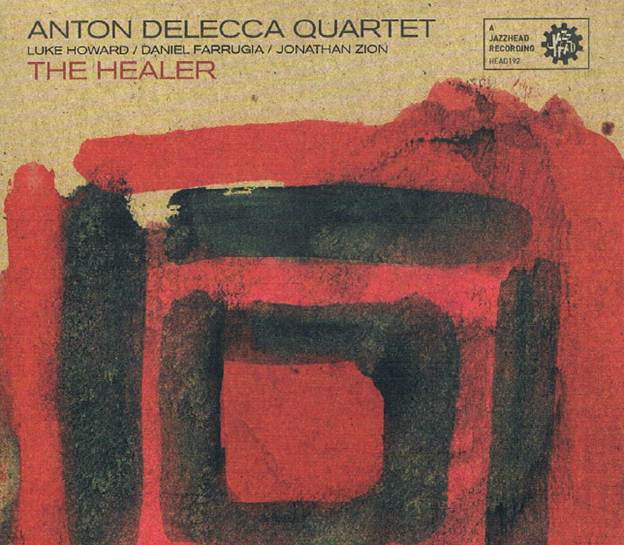 | Anton Delecca Quartet - The Healer (Jazzhead)
|
This third album from Melbourne quartet led by saxophonist Anton Delecca features eight originals and two standards. Delecca is well known for his quartet work and membership of soul-funk group The Bamboos; he’s also toured with several notable US jazz performers
The mood in this collection varies but mostly the style is bop-influenced mainstream, with some tracks featuring mid-eastern aspects. Each member contributes strongly, especially pianist Luke Howard. The opener The Ark has a mid-eastern modality, moving, after some intricate piano and tenor unison passages, into Delecca’s swift-running solo over substantial piano chords and mounting bass and drums rhythmic patterns. When the piano solo comes it’s heralded by Jonathon Zion’s staccato bass intro and soon builds its flowing sequence into an interesting melodic complexity. The Rogers and Hart standard Bewitched, Bothered and Bewildered is expressively phrased by Delecca and soloed on pleasantly by both piano and tenor. The other standard, Cole Porter’s Love for Sale features alternating straight four and Latin beat passages, established by drummer Daniel Furrugia and the solos are effective, but it’s difficult to find anything very innovative to say musically on such a well-worn piece.
The title track begins with soft, stately solo piano chords before bass and drums set up an eastern beat for the sax to join in with the melody and the quartet proceeds to its sombre, soulful piano conclusion. Sahadi’s delivers another mid-eastern style theme moving through minor intervals in a solemn procession to its subdued ending. This album is graciously listenable – especially the eastern influenced compositions – without any attempt at pushing boundaries
   
|
John McBeath
Previously published in The Australian Jan 2014 |
| Back to Index |
| 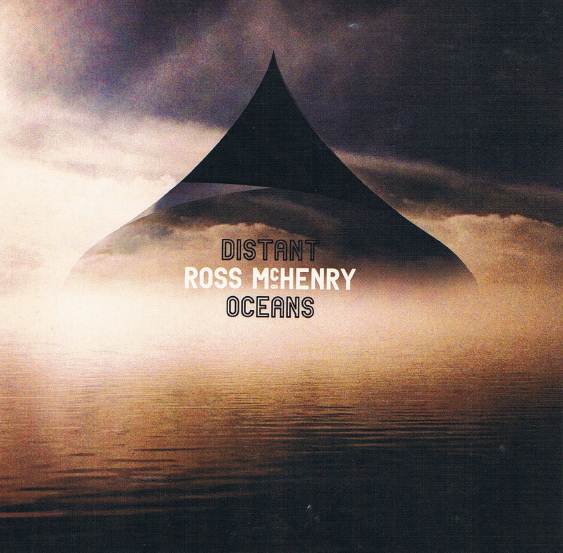 | Ross McHenry - Distant Oceans (First Word Records)
|
This new album by septet leader and composer, Adelaide bassist Ross McHenry, is contemporary on many levels. It utilises electronic programming, laptop effects, live electronic manipulation and the luminary of loop pedals, saxophonist Adam Page. The end result though is more orthodox than might be expected. The opener Intercosmos begins with exploratory tremolo effects offsetting Luca Spiler’s trombone, moving after Myele Manzanza’s medium drum beat establishment to a pretty guitar and chimes theme. This galactic piece proceeds through various movements involving Jon Hunt’s edgy bass clarinet and Mark de Clive Lowe’s keyboards, to a gradual fade of its tuneful melody.
Distant Oceans Pt 1 begins with a slower, soft rock beat and effects that establish distance, adding a front line ensemble of a pleasing refrain which too soon plunges into Pages’s frenetic tenor solo. The title track Part Two, a thematic extension of Part One also features hectic work from Page, this time on soprano. Two short tracks, Interlude Pts 1 & 2 are quite relaxed and soothing, as is the longer Prayers, with a haunting bass line and gentle rhythm at first, subsiding later into a raucous maelstrom of incongruous, unprayerful tenor sax. A more interesting piece, Lights Across the Sky includes effective portrayals of a cosmic narrative, especially due to Dylan Marshall’s upwardly mobile guitar and the leader’s insistent electric bass. A bass riff and dreamy keys make a good start to Malmsbury Shale with emphatic guitar added to an attractive theme. McHenry has enormous composing and arranging potential, but this album demonstrates a need for more leadership and direction in production
   
|
John McBeath
Previously published in The Australian Jan 2014 |
| Back to Index |
| 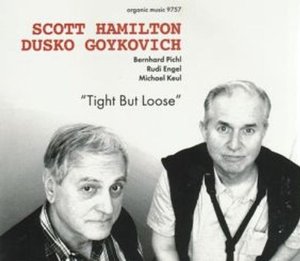 | Scott Hamilton and Dusko Goykovich - Tight But Loose (CD Baby)
|
Scott Hamilton recorded with the Bernhard Pichl trio back in 2009 resulting in the fabulous How About You disc. With this Tight but Loose session, Scott is paired with Dusko on Flugelhorn/Trumpet and the proceedings are magical. Dusko's blend of tone and style is elegant, mellow and hot. On ballads, and with the mute in (as on Angel Eyes), Dusko is quintessential fifties cool. Scott is as keen as ever with his fluid, swinging ideas and full tone. The recording is first rate and tends to place the piano playing of Mr. Pichl in a slightly more favourable light than on the previous How About You session. The bonus of exploring Scott Hamilton's recordings is that you get introduced to so many fine rhythm trios along the way and this German trio is something special. My personal favourite is the drummer who is light, crisp and nimble up top but has a fat bottom end when pulling out the stops and an unusual sounding cymbal (an inside out Chinese cymbal) that adds extra timbrel colour to his palette. His fast and furious exchanges are precision timed, delivering a big and flexible sound with shades of the beer garden. This is a fine programme and is a brilliant follow up to the previous get together (minus Dusko) on How About You, where Michael Keul really shines. Europeans have their own jazz history, these recordings continue that enduring, creative legacy
    
|
Wayne Dawson
|
| Back to Index |
|  | Elodie Sablier - Vertigo (CD Baby)
|
Pianist Elodie Sablier has pulled off a stunning debut recording of original solo piano pieces that resonate with the hallmark echoes of the French classical tradition. Neither too overtly dramatic nor too languid, Elodie treads the middle ground of an engaging, pensive tastefulness that spins a gentle, hypnotic web of sure footed musical discipline. Throughout, juggling left and right hand patterns are held in balance by an exquisite sense of timing that reveal an understanding of the mechanics of motion and dialogue (and a breezy hint of jazz syncopation), but it's Elodie's sense of the spirit that pervades. Her choice of titles to each piece adds to the intrigue and supplies the finishing poetic touches. It's difficult to select favorite tracks, each on its own is a tease, the sum is greater than its parts. So this is a fine production from a French pianist who immigrated to faraway Australia determined to learn English by cutting off an easy retreat home. Fortunately, she fell into the hands of one of Melbourne's finest recording engineers, Robyn Payne, who has rendered these delicately wrought pieces with clarity and balance. The moral of Elodie's story is: learn what you can, then follow your own muse
    
|
Wayne Dawson
|
| Back to Index |
| 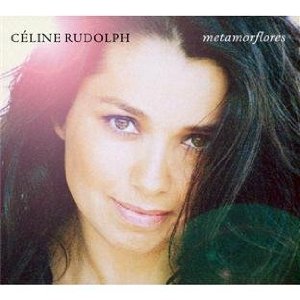 | Celine Rudolph - Metamorflores (Enja)
|
Metamorflores has for its world view African rhythms, the French chanson tradition, a string orchestra and even a couple of English pop tunes: the Beatles Norwegian Wood and George Harrisons Here Comes the Sun, mixed into the programme (which I thought were the lamest tracks on this otherwise enjoyable disc). Celine is better off with her own compositions or with those that stay outside the English pop idiom of yesteryear. The reason being is because her own gifts of originality and understanding of Brazilian, African and continental European music offer the richest of pickings. The title track is hers and it’s gorgeous, along with several other of her originals. Nothing quite prepares you for Ragga Heliotropical though, a humorous impressionistic foray into mild jungle fever, but the jewel in the Metamorflores crown for me was Samba em Preludio; a slow measured masterpiece that shows off the true beauty to Celine's voice as she ascends the notes, controlling the climax and its descent like the true artist she is. This unusual recording finishes with another fine track called A Medida da Piaxao, where Celine improvises on vocalised inflections to stunning effect through the middle section to the song. Great production, if you don't mind not understanding the words to the songs (that is if you’re trapped in a monolingual English like me), you'll nevertheless be in safe hands. Booklet contains lyrics. Incidentally, this recording was the winner of the Deutscher Musikpreis award for Jazz 2010
    
|
Wayne Dawson
|
| Back to Index |
| 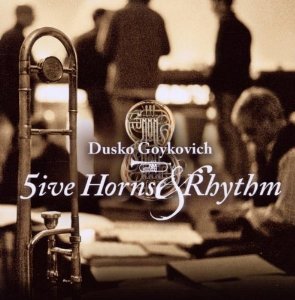 | Dusko Goykovich - 5ive Horns & Rhythm (Ais)
|
One of the major contributors to the art form of World Music, on this 2010 production Dusko returns more specifically to his jazz arranging roots with as to be expected sterling results. Larger ensemble projects like this balance on the knife edge between success and failure by the x factor of the recording engineer regardless how well everything is played. There are moments when I thought the bass sounded a bit tubby (which is unusual as Mr. Gjakonovki's sound is perfect on previous Goykovich classics like Samba do Mar and Samba Tzigane); but this is really minor as the ensemble has been gloriously captured cementing yet again an enduring partnership between enja records and Mr. Goykovich, who contributed to this production as well as . . . "All arrangements by Dusko Goykovich, all compositions by Dusko Goykovich except 'Unit Seven' by Sam Jones and 'Back At The Chicken Shack' by Jay McShann." The maestro is fully in charge for this latest incarnation of the 5ive Horns & Rhythm series. The musicians are first rate negotiators of these deft arrangements and although I thought there was one trombone solo too many, my patience in waiting for the baritone sax to add a darker contrast to the brass was justly rewarded. It’s a pity Mr. Richardeau wasn't put to more use as his one solo was a cracker; great tone! However the fabulous Fulvio on tenor sax made up for the reeds as he laid down some solid work. My other pedantic trifle was that I thought the piano should've dropped out altogether for Samba Tzigane but in the end, it really didn't matter as it was a joy to hear that beautiful tune with added instrumentation from its previous piano less recording in 2006, which is well worth having also. Dusko has loyally remained a torch bearer for Miles (Davis), his main formative influence and friend, and so Ballad For Miles reappears here, making this project a small percentage compilation; but as for the rest, this is no messin' around, straight up groovin' of the joyous melodic kind until those last two tracks, One For Klook and Tokyo Shuffle Blues just bury you in the heat and dust of it all; recommended with a good bottle of red!
    
|
Wayne Dawson
|
| Back to Index |
|  | Dusko Goykovich - Sambo Do Mar (Enja)
|
Trawling back through Dusko Goykovich's recordings is becoming a very satisfying experience. This one, Samba Do Mar (produced 2003), is a really superb quartet outing that gives full exposure to Dusko's intimacy and warmth. Three out of the ten tracks are by Dusko (including the title track), four by Sergio Mihanovich, two by Jobin and one by Villa-Lobos (his classic Bachianas Brasileiras No. 5 seems tailor made for the maestro). This is a stunning programme of material that's seems to glow all the more as muted trumpet gives way to open trumpet and flugelhorn. Finally, just when you think this can't get any better, they finish off with Sergio Mihanovich's Sunset, leaving you shaking your head at the unforced mastery of it all. The booklet is a bench mark of how CD booklets should be with full page photographic portraits of the musicians accompanied by brief biographies of them and the composers. Samba Do Mar is an exemplary production that was followed up three years later with the magnificent Samba Tzigane; another piano less masterpiece that has, along with Samba Do Mar, all the suppleness of a women in its gently moving rhythms
    
|
Wayne Dawson
|
| Back to Index |
| 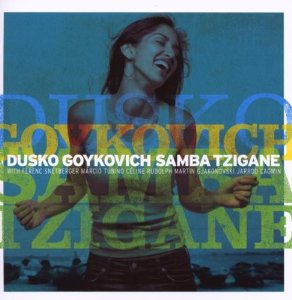 | Dusko Goykovich - Samba Tzigane (Enja)
|
This beautifully produced CD and the music it contains is a real cleanser for the spirit and reminded me of the Stan Getz/Luiz Bonfa album, Jazz Samba Encore. On that classic album from 1963 it was Maria Toledo who provided the vocals on several tracks; with Samba Tzigane we have Celine Rudolph on vocals to 4 out of the 11 tracks and her style is more engaging and vivacious (dig the way she ad libs toward the end of Samba Triste!). Instead of the caustic edge of Stan Getz's tenor, we have the pour down like silver warmth of Dusko, who sounds even more mellifluous when paired with the flute of Marcio Tubino. The arrangements (very much a group effort, with a couple by Jobin and one by Villa-Lobos and Dora Vasconcelos thrown into the mix) ensure there is space for all to shine which means when the perfectly compatible soloists have eloquently finished their lines, bass and percussion display the grooving glue that adds to this well considered texture. This is a very fresh sound, made all the more so by the clean notes of the guitarist Ferenc Snetberger. If Dusko is the wizard who pulled this project into existence, then Celine Rudolph is the enchantress that could waylay the wiliest Ulysses. Beware the gypsies when shipwrecked, especially when the sirens song is full of the flavours of Brazil and the Adriatic. Booklet contains lyrics and photos
    
|
Wayne Dawson
|
| Back to Index |
| 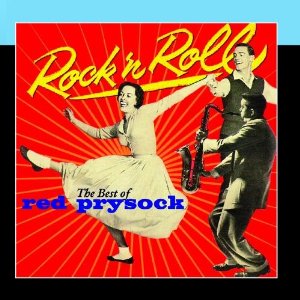 | Red Prysock - The Best of Red Prysock (Master Classics Records)
|
Firstly, thanks to those responsible for keeping this music current, reborn from old vinyl and earlier CD release. I read a description of some 1950s Buddy Lucas R&B recordings that is worth repeating here for this Red Prysock material . . . "A marvellously anarchic slab of proto Rock 'n' Roll". That's what this is. Track 2, Blow Your Horn, is a no nonsense, live rabble rouser that conveys all the excitement and release of those new genre times; Rock 'n' Roll before the electric guitars took the lead away from the tenor sax. It was rhythm and blues that had the baby and on these sides you can hear it being born. Red's music looks so easy on the page but just try playing it that way and it's a whole lot more elusive; the repetitive rhythmic patterns (interspersed with over blown octave notes) that sound so simple but soon become fiendish. No wonder the best dancers of this music look triple jointed. The sheer freedom to respond and react however you feel as lightning bolts of energy are fired off from the band with the only thing stopping complete loss of gravity is that big, heavy back beat boring holes into the ground; stomp as well if you wish too!
My only brickbat about these releases is that they have no information about who, what, where, when. A must companion disk is the Swingsation release of Red Prysock where some information is available on the cover. Also in the Swingsation series is Sam 'The Man' Taylor, every bit the equal to Red Prysock. Get those three and you'll be in R&B, Rock 'n' Roll heaven
    
|
Wayne Dawson
|
| Back to Index |
| 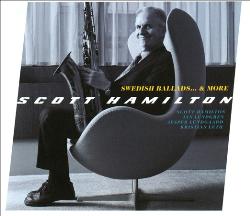 | Scott Hamilton - Swedish Ballads (Stunt)
|
Scott Hamilton's latest offering has him back in Europe which can only mean good musical news. I now have 10 CDs of Scott's music and 7 of those are tenor sax quartets with piano trio backing. You may think 'enough already', replace the piano with electric guitar and acoustic with electric bass, just for a different slant; but the problem is, all those tenor quartet recordings are pure nectar and this latest is no different
Straight off the bat with the opening track the ghost of Ben Webster is breathing through with a lovely, low key rendition of 'Dear Old Stockholm'. The obvious is also stated with yet another superbly recorded, fulsome sound with the bass sounding especially beautiful and the sax (as always) perfectly miked. 'Swing in F', written by Ollie Lind, has shades of Coleman Hawkins Hollywood Stampede passing by but just when you feel things are traveling all too nicely Scott gets down and dirty with some wailing. The great sounding title 'You Can't Be In Love With A Dream' is a duet with tenor and piano. After the piano solo on 'Stockholm Sweetnin'' Scott comes back with some fine runs but by this stage I'm missing a more interactive drummer. The unobtrusive brush work of Kristian Leth places this project next door to Scott's Nocturnes and Serenades recording, although ‘Ballads’ is a softer setting. It certainly won't bring in a younger audience, but for all you middle aged romantics out there who fantasise of snowed in log cabins, candlelight and wine, it has its melodically seductive purposes
    
|
Wayne Dawson
|
| Back to Index |
| 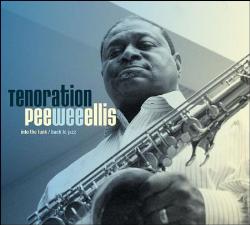 | Pee Wee Ellis - Tenoration (Art of Groove)
|
Pee Wee Ellis has been around a long time. He was a central figure in the famous James Brown band of the 1960s, being both musical director, tenor sax player and involuntary mediator between the rest of the band members and J B. That was the time of such monumental classics like Papa's Got a Brand New Bag, Cold Sweat, It's a Man's World etc. In the 1980s he teamed up with Van Morrison and in 1998 he appeared on one of the late Bert Jansch's finest later albums called Toy Balloon, where he delivered an unforgettable solo on the track How It All Came Down. It was when I finally made the connection between the player of that solo being the same tenor player with the James Brown band that I scrambled for the Google bar to enter a search on his name, leading me to this double CD 'Tenoration' on Amazon
Tenoration is a great concept. The first disk is called 'From jazz to funk' . . . and the second is called . . . 'and back to Jazz'. Below is a list of personnel and instruments for each disk:
From Jazz to Funk . .
Pee Wee Ellis - Tenor Saxophone
Dan Moore - Keyboards
Tony Remy - Electric Guitar
Patrick Scales - Electric Bass
Guido May - Drums
. . . and Back To Jazz
Pee Wee Ellis - Tenor Saxophone
Gareth Williams - Grand Piano
Laurence Cottle - Electric Bass
Guido May - Drums
The first disk offers the best jazz-funk your ever likely to hear. The stamina levels are intense and everyone holds the line with the over ten minute 'Sticks' (a piece written by Julian Adderley) representing a high point. That’s when the boys give the drummer some in a series of four bar exchanges with the tenor, a high point of the high. The electric guitarist Tony Remy is just sheer dirty gorgeous, the electric bass delectable and Dan Moore on keyboards interacts with the rhythm the best way possible. As for the boss, he never falters, tearing off one incredible line after another with shades of Junior Cook, Harold Land, Joe Henderson and Stanley Turrentine flitting past but the finished delivery is pure Pee Wee
The second disk is just as up on it, with the same drummer carried over for the entire set (how could you let him go?). The Grand Piano and different bass player make for an interesting take and the fabulous tune 'Sticks' gets another workout but at half the duration. There are several Ellis originals on here, two for each disk, but I really fell for 'Now Go On'. The bands take on Eddie Harris’ Freedom Jazz Dance is another one to watch out for
This is one hell of a seriously smokin’ project, the cover photos are great and the production is perfect: recorded, mixed and mastered in Germany toward the end of 2011. Don't expect to sit still, you'll become the dancer you never thought you could be!
    
|
Wayne Dawson
|
| Back to Index |
| 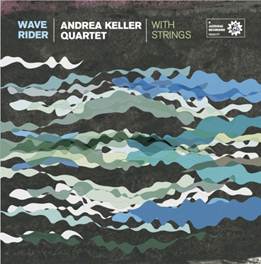 | Andrea Keller Quartet with Strings - Wave Rider (Jazzhead HEAD 191)
|
This might be Andrea Keller's 11th Album but in years to come it will be seen as her landmark recording. The writing is definitive Keller and the conception for these pieces for small group and string quartet is quite remarkable in a sort of Mingus meets Messiaen way. It's highly thematic and not one of the 15 tracks seems out of place in this context. Keller formed her longstanding quartet in 1999 with tenor saxophonist Ian Whitehurst, trumpeter Eugene ball and drummer Joe Talia. I wrote of Andrea Keller in 2007 "Wearing another's hat never really changes who you are. Received as a gift, it should be adapted to suit your own purposes". Keller has grown significantly in stature in the jazz world and these days she wears her own hat. ‘From Natures Fabric’ opens with the resonant but curiously growing sound of the inner piano prevailing before a conventional but pensive piano treads warily and makes way for an awakening few notes from trumpet and saxophone. Very much reminiscent of how The Necks might set the scene. Keller plays a rolling repetitive theme while trumpet and saxophone ask a restrained question-like melody. The following track ‘Ingress’ opens with Joe Talia’s cymbals sprinkled against a single plucked cello note before a dissonant almost flute-like violin contribution makes way for Keller’s spatial choices as if she was randomly plucking harp strings. The piece concludes with the violin once again improvising against the same cello note, but now in unison with trumpet and saxophone as if to perfectly come full circle to complete the composition. The restraint and relative simplicity of these two opening tracks set the scene for more complexity as the disc continues without compromising the emotional connectivity inherent within the music
    
|
Peter Wockner
|
This tenth album from multi award-winning Melbourne pianist Andrea Keller combines her well established bass-less quartet with a string quartet presenting various, highly individual works of her own composition. The style is a hybrid of European contemporary classical profiles infused, quite lightly, with jazz modalities. The longest track – just over ten minutes –Patience, is a good example of the type of musical narrative used throughout the collection. It opens with deep piano bass notes contrasted against high treble motifs in a tenebrous mood joined by Eugene Ball’s languid trumpet harmonized with Ian Whitehurst’s tenor sax, before Joe Talia’s muffled mallets arrive building to the quartet’s patient finale.
A more joyous piece, Breathing In opens in a loping rhythm established on piano with orchestrated trumpet, sax and strings gradually surmounting before the piece segues into strings, piano and drums maintaining the jumping tempo while trumpet solos jubilantly overhead. From Nature’s Fabric glistens and shimmers in its entirety with strong piano statements whilst there’s a symphonic jazz feel to Mister Music including an impressive tenor solo against orchestral off-beats. An energetically tongue-in-cheek fanfare opens Queen For Tea IV and after interspersed piano statements continues a hallucinatory “Through the Looking Glass” effect to conclusion.
The final track, appropriately entitled Egress features a lyrical piano theme in front of soft ensemble chords and Talia’s restrained brushes. These pieces are most of all compositional, rather than performance-oriented and the compositions are extraordinarily descriptive. The arrangements too are imaginative, original and orchestral in concept, while occasionally leaving solo spaces, giving the overall collection a fascinating symphonic aura.
   
|
John McBeath
Previously published in The Australian Jan 2014 |
| Back to Index |
| 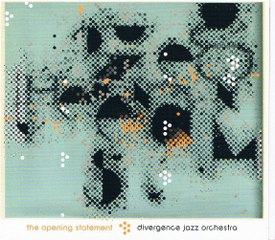 | Divergence Jazz Orchestra - The Opening Statement (Independent)
|
Specifically formed by composer Jenna Cave and trombonist/leader Paul Weber in 2012 to perform music by Cave and other Australian composers, young Sydney seventeen piece band The Divergence Jazz Orchestra has released its debut album. On this collection of seven tracks, all composed by Cave, various band members are showcased in a diversity of compositional styles from ballad lyricism to Afro beats. There’s a strong musical narrative, including a fine climactic sense throughout each track with arrangements that include occasional rhythmic changes. Adding adroit voicings, melodic themes and some fine soloists has produced a highly listenable album.
The opener A Stranger in Helsinki has the band pushing along in a Senagalese rhythm using smart exchanges between the brass and reed sections underscored by Luke Liang’s guitar ostinato and later his skipping solo on muted strings. The style and tempo alter for the start ofDear Miss Upstill delivered as a soft ballad stated by Will Gilbert’s trumpet, ahead of a temperature change as the rhythm shifts for Michael Avgenicos’s fast-running tenor solo. Odd Time in Mali sets an Afro beat on guitar against some splendid staccato brass section work followed by Paul Weber’s commanding trombone and Mathew Collins’s trumpet overriding the declamatory ensemble while guitar, bass and drums drive it all along.
The title track is given over to whole of orchestra playing with Cave’s beautiful scoring and conducting to establish a memorable theme that develops light and shade by skilled use of diminuendo and finely controlled section playing. With this album M/s Cave has established herself as a top level composer, arranger and conductor in Australian contemporary jazz
   
|
John McBeath
|
| Back to Index |
| 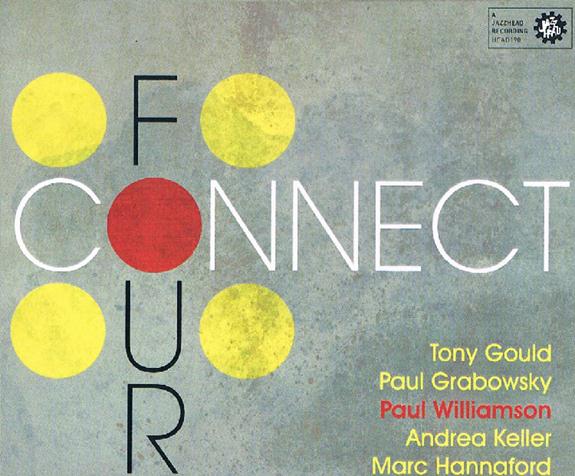 | Paul Williamson - Connect Four (Jazzhead)
|
These nine tracks feature Melbourne trumpeter Paul Williamson in duets with four different A-level pianists: Tony Gould, Paul Grabowsky, Andrea Keller, and Marc Hannaford. All compositions, save one, are by Williamson and they encourage each pianist to inject their individual approach and style on this, the trumpeter’s eighth album. The piano parts are not merely accompaniments, but are arranged in a true duet manner with space for piano solos. The mood is mostly relaxed and introspective, almost semi-classical at times and the differing piano characteristics add interesting comparisons and textures. The opener with Gould, Piece for Peace like many in the collection, is calming and reflective with cadenza-like trumpet passages and flowing piano
Buzzby featuring Hannaford, after a staccato unison theme, flies quickly and busily as Williamson climbs into the high register while the piano stomps some mild dissonance and runs speedily. It’s back to a thoughtful, dreamy beginning in Drift, with Keller’s pastoral piano, as gradually the trumpet builds tension, adding high level tremolos. Grabowsky’s composition and piano work on Helix is a tentative piece of long trumpet notes and a piano solo that drifts and wanders melodically over the changes in a satisfying way, before the trumpet returns with growly concluding effects
The second of Grabowsky’s three appearances, Good Morning Melancholy opens with a beautifully portrayed piano interpretation of the title and continues sympathetic contributions in the improvised dialogue. Keller’s second appearance, aptly entitled Flow, does exactly that in her intricate solo using rhythmic arpeggios and some stabbing chords which also work well behind the trumpet. One or two mildly blemished trumpet notes are not sufficient to detract from the appeal of this unusual album
   
|
John McBeath
Previously published in The Australian Dec 2013 |
| Back to Index |
|
| Archives 2013 |
| Archives 2012 |
| Archives 2011 |
| Archives 2002-2010 |
|







































































